

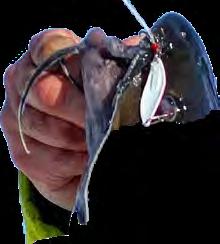


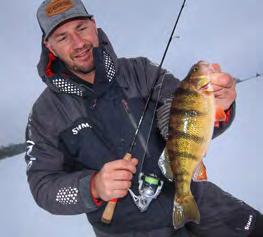


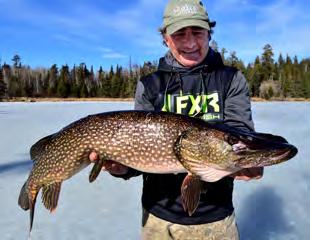













WINTER 2023 VOL. XXX No. 1 •46SPOONS & ELECTRONICS ON ICE PLAYING THE LIPLESS CARD •10 YOUR EYES BENEATH THE ICE •2 •42 BURBOT BEYOND BELIEF Plus More Great “Stuff” In side! years Celebrating 30
the inside of our rental hut enough in order to look down the hole! Not only did this create an uncomfortable strain on one’s neck but rarely did we ever actually see anything! That’s not to say under certain conditions, sight fishing through the ice can be effective and a lot of fun!
Today, if I don’t have some type of electronics to be my “Eyes Beneath the Ice”, I’m really not too interested in venturing out onto the ice. Being able to see if there are fish where you’re fishing or how the fish are behaving is critical to success on the ice!
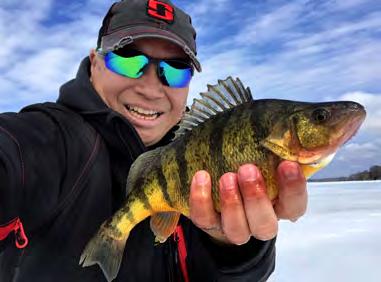



When you’re ice fishing especially in deeper water and you aren’t employing any type
as well be fishing blind! Without the aid of a sonar unit or underwater camera, you’re just hoping to get lucky and yes sometimes luck is a factor that plays out for some people. Unfortunately, I and many others are not that lucky. I like to put the odds in favour whenever possible. At least if you know that you’re around fish but you’re not catching any, you can make adjustments to your presentation or change lures/colours to hopefully trigger strikes.
As far as sonar units are concerned, you can always adapt your unit from your boat and use it out on the ice as well. Since there are so many well packaged ice bundles from all the sonar manufacturers, I would suggest getting an ice fishing dedicated unit/bundle. Even the most basic of these units such as a Garmin Striker™ 4 Portable
an acronym for “Compressed High Intensity Radar Pulse”, which is a more advanced method of processing and displaying traditional 2D sonar. CHIRP uses bursts of different frequencies, providing more detail, less surface & water column noise and most importantly better target separation.

Many CHIRP sonar units like this Garmin unit will always you to split your screen and include the flasher mode as well.


The better your target separation, the easier it is to see fish especially if they’re tight to the bottom! CHIRP sonar with its alternating frequencies also reduces the amount of interference that you might get from other nearby units!
I like a traditional CHIRP unit like the Garmin ECHOMAP™ UHD 73cv Ice Fishing Bundle when I’m trying to stay mobile as it is compact and lightweight.
Just Fishing . 2 Winter 2023
Taking full advantage of the power of your electronics will keep you on “JUMBO’s” like these more often!
(Continued on page 4.)
Using today’s advanced electronics makes it a lot easier to fill that bucket for a tasty fish fry later on!


A Line From “Big” Jim
Hard to believe that one area of the continent is full steam ahead ice fishing and others are still in boats and kayaks when they are usually on the ice. It has certainly been an up and down start to winter but it always gets here even if Mother Nature isn’t always on the time. When She does arrive we have you covered to catch the most popular species and even a couple that are on the radar and becoming many anglers favourite challenges.
This issue is packed with great information including Clam Corporations Ice Team Manager & hard water guru Matt Johnson giving us a run down on how to catch catfish with much of the tackle you already have. The Matity Brothers, who I had the pleasure of meeting at the Ultimate Ice Fishing Show continue on their quest for the mighty Burbot, which are plentiful & make for great table fare. David Chong schools us on the use of advanced electronics below the ice and how they’ll help you put more fish topside on almost all outtings.
Sir Gordon Pyzer gives us some “Lipless” crankbait tips for a myriad of gamefish this winter. Lake Simcoe King Wil Wegman offers up exactly what you need to do with a group of must do tips to help any angler be more successful. Wait there is more! Tim Allard, Dr Stephen Cooke and our home grown Bassmaster Elite Pro Jeff Gustafson adding his take on fishing spoons in conjunction with your electronics. Them we finish up with Chef Tait sharing a delicious recipe for Walleye Rockefeller to try on your harvest...Yummy! Last but not least, Target Walleye with their unique take on all things walleye.

Fish safe folks, ice is definitley sketchy this year in many areas... don’t be the one!!!
Unsolicited articles are accepted and will be considered for publication provided they are original and have not appeared in other publications.
Publisher
“Big” Jim McLaughlin
Managing Editor
Tammy Wight
Digital Marketing
RYP.Media
Contributors
Gord Pyzer
David Chong
Tim Allard
Cameron Tait
Jeff Gustafson, Jeff Matity
Dr. Steven J. Cooke
Matt Johnson, Wil Wegman
Box 214
Seeley’s Bay, ON K0H 2N0
Email: info@justfishing.ca
www.justfishing.ca
All Rights Reserved
Reprinting or reproduction in whole or in part is forbidden, except by written permission of the publisher.
On the Cover: Main photo – Matt Johnson, Catfish Play in the Snow Too!, Your Eyes Beneath the Ice, photo – Dave Chong, Burbot Beyond Belief!, photo – Jeff Matity, Spoons & Electronics on Ice, photo – Jeff Gustafson, Playing the Lipless Card, photo – Gord Pyzer.
(Your Eyes Beneath the Ice continued from page 2.)
It comes with a GT10HN-IF transducer, which is a hi-narrow CHIRP transducer that produces excellent target separation. Its narrow 7–16 degree beam cone provides a very hi-def precise fish and lure detection. The narrower the cone angle on your transducer, the easier it is to pinpoint where the fish are located beneath you.
The 20-degree by 135-degree scope of the Garmin LiveScope™ in both forward and down modes provides an ice angler a large area of view!

The wider your cone angle, the more area you’ll cover but it will be harder to determine where the fish are in your cone. To have a better understanding of how the cone angle works with your CHIRP transducer, imagine a flashlight with an adjustable beam angle. The narrower your angle is, the more concentrated your beam will be. The wider your beam angle is, the more area coverage you’ll see. There can be arguments for the benefits of both a narrower or wider cone angle.
Some ice anglers still prefer a flasher type of sonar unit! A flasher displays real-time sonar data from beneath your ice fishing hole, while traditional LCD type units even with CHIRP technology show historical sonar data. A flasher unit will show you what is happening beneath your hole at that very instance, while a 2D sonar unit will show you the history of what’s been happening beneath you. For certain species especially ones like lake trout, historical data
Garmin’s LiveScope™ units are a “Game Changer” on open water as well as on the ice!
is
great for judging a fish’s mood. The history on a 2D sonar can help you determine how aggressive a fish is and if it’s willing to chase or not. A flasher would be considered one dimensional as it cannot display any history.
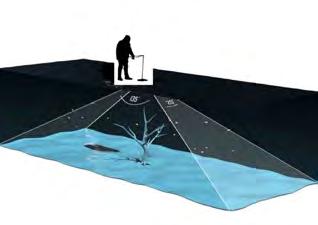
The more popular flasher types units are made by Vexilar & Marcum, although many 2D sonar do also have a flasher mode that one can use if they prefer. You can also split your screen and have a flasher display on one side and a 2D LCD display on the other.
(Continued on page 6.)
Just Fishing . 4 Winter 2023 IN THIS ISSUE SPECIAL FEATURES Your Eyes Beneath the Ice..........................2 Playing the Lipless Card........................10 Lake Simcoe on Ice...............................18 Glittering Baits for Golden Walleye.......26 Catfish Play In the Snow Too!..................34 Can Science Help to Identify Cheaters?......38 Burbot Beyond Belief!...................................42 Using Spoons & Electronics on Ice..............46 DEPARTMENTS A Line From “Big” Jim ...........................4 For the Love of Cooking.........................31 In The News............................................32 Tubman’s Tips & Techniques ..................45 Target Walleye Report...........................50
“Big”
Jim

In 2015, Garmin set the fishing world on its ear with their introduction of Panoptix, all seeing sonar. Panoptix was the first product to offer real-time live forward, backwards, sideways & down facing sonar returns to the average angler. Garmin Panoptix is a multibeam transducer that utilizes a phasedarray scanning sonar technology to provide recreational anglers a live view around their boat or ice hole. Then no sooner that anglers were getting used to incredible imaging provided by the Panoptix sonar units, merely 3 years after it’s introduction, Garmin releases Panoptix LiveScope™. Panoptix LiveScope™ is a live scanning sonar that provides higher resolution and easier to interpret images.
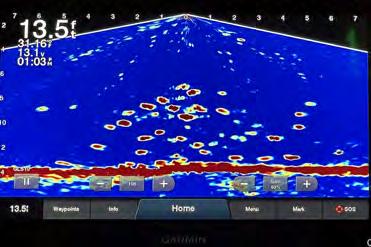
The Garmin LiveScope™ with its LVS32 transducer and GLS10 sonar box quickly became the rage of the fishing world. Immensely popular in many different sectors of the angling community, it caught on like wildfire in the competitive angling circles and possibly even grew more popular in the Crappie fishing & ice fishing communities.

To be honest, when Garmin first introduced a LiveScope Ice Fishing Bundle, I was very skeptical as to how many they would
sell at a $3,000+ price tag. There is no fishing sector that values DIY projects more than the ice fishing community. I just didn’t believe that there was that great of a market for such a costly unit but I was quickly proven wrong. At the 2018 Great Canadian Ice Fishing Expo, the largest fishing electronics retailer, Radioworld sold out what they had at the show and there were many more units were placed on order.
Again “Seeing is Believing”, the LiveScope™ technology is ideal for ice fishing as your transducer sits stationary so it produces crystal clear images. Quite often you can tell what type and size of fish that you’re seeing on your screen. It’s 135 degrees by 20-degree coverage angle allows you to see clearly up to about 80 feet away when in forward mode and probably over 100 feet with the latest LiveScope™ Plus™ LVS34 transducer.
Your coverage in the down mode will be determined by the depth of the water that you’re in but with a 135-degree angle, it will cover a substantial area. Your LiveScope™ transducer can be rotated so you can see all around beneath your hole. Garmin’s LiveScope™ is truly a “Game Changer”!
Just Fishing . 6 Winter 2023
Just Fishing . 18 Fall 2022 NEW
Braiding-X X45®
Cork
Fuji®
TATULA
LIGHT
6.2
LT
Zaion®
NEW
T-Wing System
Compact Frame Design Zero Adjuster 6.9 Ounces Tatula
The perfect
for
Check
at a retailer near you. www.daiwa.com/us (Continued on page 7.)
(Your Eyes Beneath the Ice continued from page 4.)
TATULA RODS
Bias Construction
Handle with Spider
FazLite Guides
LT
& TOUGH SPINNING REELS
oz. (2500 size)
Light Tough
Body Digigear™
TATULA 100
THE
SMALLEST & LIGHTEST TATULA BAITCASTER EVER!
(TWS)
reels — now smaller and lighter than ever.
match
our new Tatula rods.
‘em out
Watching a school of JUMBO Perch swim around beneath in real time on Garmin’s Eyes Beneath the Ice is intoxicating!
One very important tip that I have for you when fishing with a sonar unit or an underwater camera is to drill that extra hole for your transducer/camera. Countless number of times I’ve seen a big fish lost at the hole because the fish got tangled in the transducer/ camera cable or got off, while the angler was trying to lift the transducer out while fighting the fish! Keep the hole that you’re fishing in clear of obstacles and do be mindful of your transducer cable even if it is in another hole. The same goes for when you’re using an underwater camera.
There are quite a number of ice anglers who prefer to use an underwater camera as their “Eyes Beneath the Ice”! Again, this is an extremely useful tool which enables you to see firstly if there are fish around you and secondly what type of mood that they are in. Being able to watch how fish react to your lure or presentation can often provide that critical clue that will ensure catching success while on the ice. There are a number of companies that make underwater cameras, Aqua-Vu, Marcum, Vexilar and a few lesser-known brands such as Eyoyo, Anysun, MOOCOR and MOQCQGR.

Some of the features that you should consider when looking at underwater cameras are:
on underwater cameras is often limited by light levels, the clarity of the body of water that you’re on and the amount of sediment floating around. If your camera does not come with a lithium battery, I strongly suggest replacing the stock battery with one.
• Cost,
• Screen Size,
• Recording Capability,
• Resolution, Infrared/LED lighting for low light conditions

• Cable Length,
• Battery Life.
You should also see how viewable the LCD screen is under bright sunny conditions. Many cameras offer some form of shading for the LCD screen to aid in those conditions. The effective viewing range
Aqua-Vu probably offers the widest selection of underwater cameras with various size screens (4.3”to 10”), camera resolutions ranging from 644 X 488 to HD1080P, cable lengths from 50 to 125 feet, camera views from 100 to 360 degrees and video outputs in RCA/AHD or HDMI. There are many other features available with the various models. The top of the line Pro & Quad models features on-screen depth reading, temperature, direction and touch zoom. The Aqua-Vu Mo-Pod 3 can be used with any cabled camera with a remote control to rotate your camera.
(Your Eyes Beneath the Ice continued from page 6.)
Just Fishing . 7 Winter 2023 (Continued on page 8.) Fall 2022 Just Fishing . 19 www.JBraid.com NEW J-FLUORO SAMURAI
Drilling an extra hole for your transducer or camera cable will hopefully save you from getting a trophy fish caught up in it!
MAIN LINE J-FLUORO LEADER J-BRAID LINE
it to rise away from the bottom mark on your unit. If you can’t see it, bounce it a bit and slowly increase the gain. Watch for your lure movement on the screen. Once it’s in view, adjust the gain so your lure mark reads green, maybe flickering into orange. Now you’re set. Let’s get one thing straight, though. Just because there are fish down there doesn’t
(Your Eyes Beneath the Ice continued from page 7.)
(Fall Largemouth on the Prowl continued from page 12)
Yo-Zuri Super Braid is the optimum choice as
You need to understand a bit about how sonar working order to fully understand what you’re seeing on the flasher. Check out the link if you need help. Remember, we are taking a 3 dimensional space and squashing this information into a 2 dimensional display. The circular area of the bottom becomes a wide mark on the screen and fish inside the transducer cone can be any colour and in any position,
The colours give us the advantage of knowing the different strengths of the signal marks. This can be roughly correlated to a position inside the cone. Red being the center most part, orange the area around, and green the outer edge of the cone angle. Now, just to keep things interesting, (fish, bait fish, your with larger surface areas will show redder, less surface area shows orange, and green for the smallest stuff. These two different phenomenons make reading FL

It means you could have Mr. Monster Musky, hanging way out on the edge, while your thinking you have a nice gill about to bang your waxy worm. Yet, on the other hand, you could be looking at a stubborn fish for 15 minutes, sitting exactly one foot above your line, when you remember that you just put a split shot a foot up to keep your bobber a little straighter. The colours will give you information. You need to interpret it. Experience and experimentation are the keys
Now let’s fish. Bait your lure and drop it down. You will need to fine-tune your gain often to maintain a consistent colour. This is due to the changing position and reflection of your bait. How far you let it go down depends on where you are and what you’re fishing for. This is where the actual fishing skill comes in. If you’re
When the water temperature drops to the low 40os F & the bite turns tough, there’s really something special about the triggering capacity of a subtle, Texas-rigged stick bait. Use pauses and patience to entice strikes.
baitfish commotion. The same outfit that is used to throw a Pencil can be used for fishing the Prop. As with the previous two types of topwaters that we’ve discussed this lure can be fished at various speeds depending upon the mood of the fish.


in luck, a fish will appear. It may be interested in your bait. They can appear rising from the bottom or coming from the side. A fish can appear to you to be rising straight up, but it is really coming from the side.
used, it is always a good idea to keep them in an insulated battery bag. For ice fishing, Lynac Lithium has 12.8 V lithium batteries in 9 Ah, 14.4 Ah, 30 Ah & 42 Ah capacities.
across your body when you feel weight will greatly increase your odds of hooking and landing that bass of a lifetime!
the last weeds and precipitously drop all the way to the bottom. This is a deadly zone; expect a bite – or many bites. Don’t remove your lure from the spot too quickly. Give bass a chance to respond. Under good circumstances, you can catch large numbers of bass from small, key spots

to try something different or you have to move. I know, you’ve got on your favourite lure that killed ‘em on that trip three years ago or the thought of packing everything up, pulling the stuff down the ice, to hand drill another couple of holes doesn’t sound like a lot of fun. But if you don’t do something different, you might as well go home.
Once hooked up, it is imperative to try and keep the fish from jumping. Keeping your rod pointed downward sometimes even thrusting your rod into the water while doing battle can be essential to landing that fish. As with any type of lure with treble hooks, it is virtually impossible to land every fish that you hook. So there will be times you do everything correctly and the bass will still get the better of you! This adds to the challenge and excitement of topwater fishing.
At some point in late fall, the water grows so cold that largemouths don’t respond as well to most tactics. But they’re still there. Switch to a Texas-rigged stickworm, likely salt-impregnated, and use patience to catch them. Cast out, let the bait settle – and wait. Inch it back a little, then pause again. Repeat
The method and speed that a topwater is worked is critical in order to draw strikes from fish, but the hook set is equally important when it comes to successfully landing them. As exciting as an explosive topwater hit is, topwater fishing can also be very frustrating. Because of the visual impact of a topwater strike, anglers often miss time their hook set and fail to hook up solidly with their quarry. The key to a high hookup and landing ratio with topwater lures is not to react to the initial hit and wait for the weight! Employing a sweep set
The flasher simply sees it getting closer. The fish mark itself holds a lot of information. With only little experience you can tell if fish are bigger or smaller, because the thickness of the red mark correlates to the thickness of the fish. You can also tell a fish’s attitude by the way the mark on your screen behaves. Aggressive biters can race through groups of fish to slam your bait. And you can see them coming. That’s when foretelling the near future becomes very easy. “I’m going to get a bite right... NOW!” On the other hand, finicky biters can sit by your bait for, what seems like, forever before you get the tiniest little tick.
Points of Interest
Lister is a savvy angler with a bladed swim jig and he’s got a few tricks I think you should know when it comes to fall bass. One area he frequently fishes are long tapering points. These are bass highways for fish moving back and forth from shallow to deep water.
“Anytime you can find a rock to weed transition especially on a point, make sure you fish it,” Lister said. “Rock areas will draw the heat from the sun on bright sunny fall days warming the water temperature, which in return attract baitfish and crayfish. Only a few degrees can make a huge difference when the water is cold.”
CHANGING YOuR WAYS
After you use the unit a few times in different situations you will begin to understand very well how it works. You may find that your old ways of fishing just aren’t good enough anymore. If you drill a hole and sit on it for hours without out getting a bite or seeing a fish you’re likely to get pretty frustrated. You have
Lister casts the vibrating jig beyond the target, and then swims it towards the spot. He experiments with rod snaps and stop-and-drop moves, letting the bass reveal what triggering action works best.
When targeting largemouth bass with topwater, it is important to understand their preference to ambush their prey rather than chase it. Casting your lure around ambush points such as docks, logs, weedlines, breaks and similar structure will draw those awesome predatory hits. Deeper open water fishing with topwaters for Buckets is usually more effective where there is a shad based forage. On these types of bodies of water, largemouth bass often school and hunt baitfish in packs.
Smash Smallmouth
It’s remarkable how these thickbodied worms with little action will produce big catches of largemouth bass when other
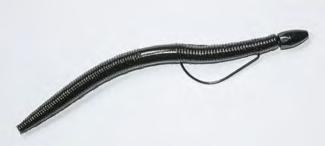
It could be said that, for whatever reason, many anglers overlook bladed swim jigs. Nowhere is this truer than when it comes to smallmouth.
To make things easier, and a lot more fun, you need to rethink your methods and equipment. You’ll find that you don’t really need a bobber anymore. Sure, there are times when you’ll use them, but a good sensitive rod with light line and a spring bobber on the tip can be much more effective. A good variety of lures and bait will give you a better chance of enticing the finicky fish to bite. A comfortable, yet very portable, fish house can make moving a snap. And, a lightweight power auger can make drilling twenty holes at a time a breeze.
There are many other methods of top watering and types of topwater lures but we’ll have to leave that for another time and another article. Until then, Set Hard! Set Often!
“Sand to weed is another great transition area anytime of the year but excels during the fall months on attracting smallmouth bass,” Lister said. “Smallmouth love to cruise sand flats on warm fall days hunting down pods of baitfish and a ChatterBait-style jig will catch them.”
That’s about it. Of course there are many more tips and tricks to help put meat on the table, but you’ve now got the most important ones. Ice fishing with an Eviler FL series flasher is not a difficult thing to do. Changing your old habits should not be either, once you see for yourself what new methodscan do for your catch. One last thing, when you find that your freezer is full and your neighbours aren’t thanking you so enthusiastically anymore when you give them a bunch of fish, it’s time to practice catch and release. Fish responsibly so others can too.
Editor’s Note



David Chong is widely recognized as one of Canada’s top competitive tournament anglers. He is also an avid multi species angler and is a strong advocate for affordable, accessible angling for all! David loves sharing his vast fishing knowledge and stories with anglers of all ages, beginners and pros alike!
Deep, up-feeding smallmouth can also be fooled with a bladed swim jig in the fall. In many respects, this is a continuation of a mid-summer pattern. Large shoreline points, bars, islands, reefs, and neck-downs are all constricted spaces where smallmouth will herd and attack shad, smelt, and other open-water baitfish inhabiting deep flats and basin areas. When smallmouth are hunting in these zones, soft jerkbaits, spinnerbaits, swimbaits, and topwaters are popular choices. On pressured systems a bladed swim jig presents a completely

Just Fishing . 8
Just Fishing . 16
(TopSide
Just Fishing . 49 Winter 2019
Bassin’ continued from page 15.)
Boat insurance. It’s what we do!
info@northstarinsurance.ca Speak to a Northstar broker today. TOLL FREE AT: 1.866.717.9295
(Bladed Swim Jigs for Autumn Bass cont. from page 45.)
www.northstarinsurance.ca

PLAYING THE LIPLESS CARD FOR PRODIGIOUS PREDATORS
 By: Gord Pyzer
By: Gord Pyzer
still deliver the fish, allowing you to catch them on a variety of finesse presentations.
OOne of the things for which I will be forever grateful is meeting up with Roger Stearns in the early days of the lipless crankbait game on Lake Winnipeg. I was doing fishing seminars at the Mid-Canada Boat Show in Winnipeg and the glass-lined hawg trough that was serving as the stage was packed with mammoth walleyes in the 10- to 14-pound range. Roger came up, introduced himself and told me that he and a couple of friends had caught the fish jigging LiveTarget Golden Shiners. He invited me to join him and it was the start of a great relationship.


In those early days of exploration, and for several years after, we never saw another angler where we were ice fishing and not a day went by that we didn’t land at least one double digit walleye. Many days it was double digits of double digits.

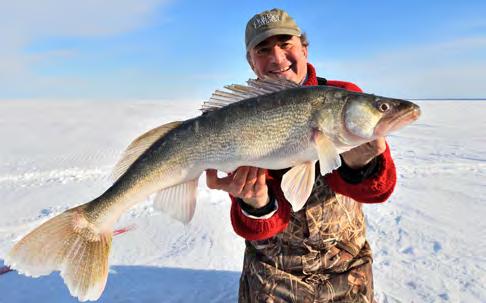
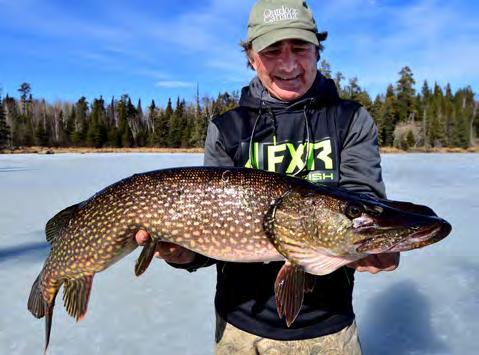


DOUBLE DIGITS OF DOUBLE DIGITS
“I remember those early days,” says Donovan Pearase, who runs Blackwater Cats Outfitter, “Roger had his first batch of LiveTarget crankbaits and he handed them out on the ice. Shortly afterwards, one of my guides nailed a 28-inch walleye that might have been the first Manitoba Master Angler walleye caught in Lake Winnipeg on a rattlebait. At least it was for me and a lot of the guys around here. That was our introduction to rattlebaits and a dozen times since the LiveTargets were introduced, other lipless baits have come along. Each one has promised to be the last rattlebait you’ll ever have to use – the mother of all rattlebaits. You buy dozens of them, they work well and then, boom, something bigger and better comes along.”
One of the first things we learned in the pioneering days was that lipless crankbaits shine in large lakes and reservoirs that are shaped like bowls and lack structure. Think Lake Winnipeg, Last Mountain Lake in Saskatchewan and the Bay of Quinte in southern Ontario. The flatter and more featureless the body of water, the better they excel at using flash, sound, vibration, colour and profile to attract the fish. It is not that they don’t work well in heavily structured lakes, too, because they do, but their ability to call in fish from afar is unparalleled. They’re no slouches either, when it comes to triggering strikes. Especially, when the walleyes are aggressive. When they’re in a neutral or negative mood, on the other hand, lipless crankbaits
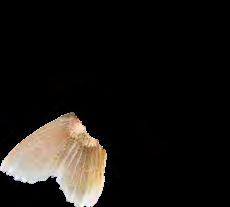

Indeed, we learned quickly to drill three holes side-byside, placing the transducer in the middle one to monitor the outside action. Then we’d jig a LiveTarget Golden Shiner in one hole, while setting a deadstick presentation in the other. Sometimes the walleyes would rush in and clobber the rattlebait, while other times they’d inspect it and then slide over and eat the finesse bait. The tactic still remains one of the deadliest winter walleye presentations ever devised.
TO TIP OR NOT TO TIP
“The only thing I wanted for Christmas one year when I was a teenager reading about the lipless game you guys were writing about was three Rattlin’ Raps,” says Just Fishing contributor, Jeff Matity. “A blue/silver, gold/black and firetiger model. I was blessed with two of each colour. I took the baits onto the ice, removed the treble hooks and attached a three-inch length of stiff monofilament line to the hook hanger. Then I tied a red #8 Gamakatsu octopus hook to the end and baited it with a wax worm. I schooled my friends that Christmas catching walleye, yellow perch, northern pike, ciscoe and burbot. I didn’t have a fish finder back then, so I’d drop the lure to the bottom, rip it up to attract the fish, let it fall, count to five and then rip it up again. I caught a jumbo perch on almost every lift. It was a complete game changer.”
(Continued on page 12.)
Just Fishing . 10 Winter 2023
The apple doesn’t fall far from the tree, Gord’s daughter Jennifer with a hefty whitefish
No complaints from Gord about catching this bonus pike.
The author, – Gord Pyzer with a beautiful Lake Winnipeg walleye






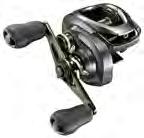






























B.J. TACKLE Rice Lake’s Fishing Tackle Specialist – A Full Service Tackle Store for All Your Fishing Needs! Hours: Closed Mondays, Tues – Sat 8 – 6, Sun 8 – 5 5103 Rice Lake Dr. Bewdley (905) 797-2632 Power Pro Super8 Slick V2 Jackall Archelon Jackall Kaera Frog Curado DC SLX Rods & Reels • Worms • Leeches • Minnows Now in Stock! SEASONAL AVAILABILITY Jackall Deracoop NEW Miravel Now Carrying LOTS OF ICE FISHING LURES TOO NUMEROUS TO MENTION!

even get a hook set. It snapped the handle and almost pulled the rod out of my hand. I yelled, Whoa, and oh my god, the savageness of the strike and fight was unreal. I managed to land the 37 1/2 inch pike and it weighed about 18-pounds.
“I had a tip up going that day, plus the jigging rod, and almost every time I moved and drilled a new hole I caught a pike. So now I am alert and paying attention. But there was no snow – it was glare ice – and the next fish took me off my feet on the strike. It just slammed me and I slipped. It knocked me off my feet. I kept doing this all day. It was the most exciting fishing I’ve ever done. I’d be jigging, jigging, jigging and then a freight train going a million miles an hour would crush the bait. Honestly, in all my years of fishing I’ve never experienced anything more exciting or exhilerating.”
NOSE TO TOES TROUT & WHITEFISH
One of the lipless crankbait features that has always impressed me, and I believe many anglers overlook, is their realistic appearance. When you hang one in the middle of an ultra-clear water column patrolled by prowling shark-like lake trout and whitefish, they stand out like sore thumbs, even when you don’t move them. But rip it up, get it vibrating and rattling and then let it plummet, and it excites the pectoral fin-splayed predators more than almost any other bait.
Two winters ago, my grandson Liam and I were ripping a rainbow trout Kamooki Smartfish under the ice, monitoring the action on our Helix sonar screens. We stuffed 13 fat lake trout back down our holes but could easily have doubled the number had we not reeled up and away from chasers in order to help the other person land a trout.
And he never varies his signature nose-to-toes violent ripping cadence. It starts with his rod tip down almost in the hole and ends with it high above his head.
Southeastern Ontario based buddy Mark Alford, on the other hand, uses a hard-tofind original Sebile Flatt Shad 65 – the one with liquid inside the lure – to annihilate winter whitefish.
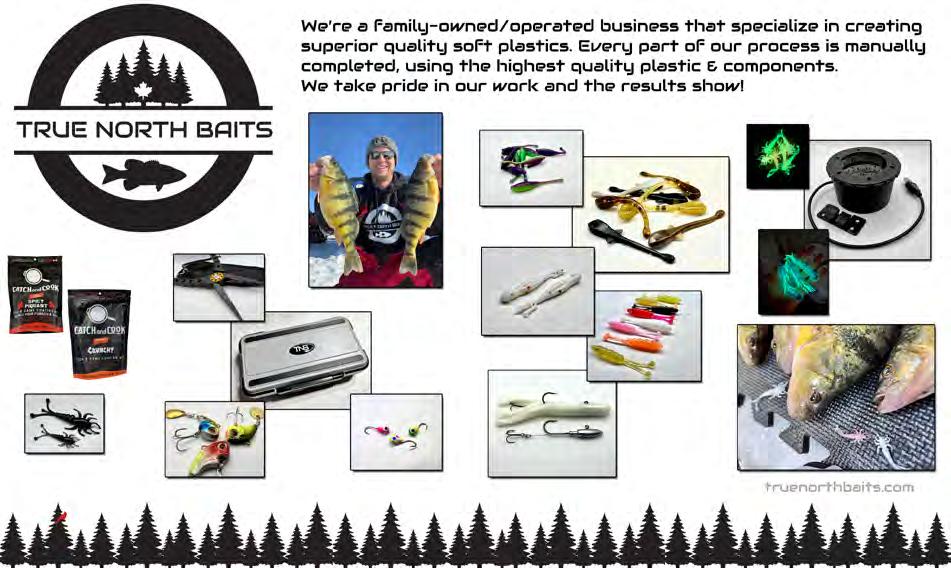


“They always hit the lure on the fall,” says Alford. “It is uncanny, but the rapid vibrating upstroke unleashes some sort of anger response and then they swallow it on the fall. They’re two completely different horizontal vibrations and motions that attract and then


Just Fishing . 14 Winter 2023
(Continued on page 16.)
(Playing The Lipless Card continued from page 10.)
It looks like Stephen Sandell’s walleye swollowed a basketball!
HT’s Tom Gruenwald shows off his massive whitefish.

trigger the fish. The Sebile 65 isn’t a small lure. It weighs close to half-an-ounce. So you look at it and think it is way too big for whitefish. But trust me, you can’t over work it. It is a whitefish killing machine.”

TOO MUCH OF A GOOD THING
When you see the fish responding the way Alford does you know you’re tuned into giving them what they want. But Matity cautions about too much of a good thing. “Few anglers appreciate the ability of a big walleye or lake trout to hear and respond to a target like a lipless crankbait,” he says. “I remember one time my brother Jason and I scored big time jigging Rippin’ Raps, while scouting the day before some friends were due to arrive. Where we fell down was appreciating that our guests were expecting to catch giant fish and lots of them. So everyone was ripping the big lipless cranks to match our previous days results. But there were too many guys huddled too closely together and our lures were no more than a few yards apart.
Yes, the fish showed up and we caught some dandies. But what was noteworthy was the fact that most of the action came on the deadstick rods. What we learned that day was that too many anglers, fishing too closely together, turned off the aggressive walleye. I should have spread everyone out over a wider area. I learned the hard way that fishing with rattlebaits is like spreading fertilizer. You need to apply it thinly for the best result. Put everyone too close together and you risk burning your spot.”
LINED UP
Something Alford has discovered is that you will catch more fish with lipless crankbaits on rods spooled with lighter, not heavier, monofilament line. “Most of the time we’re pushing the line strength envelop upwards, looking for the strongest line we can get away with,” he says. “And braids dominate. But I fish outside all winter long and catch more fish when I use the lightest monofilament line that I can get away with. I’ll often scale down to six-pound test.
Regardless of what you are fishing for – walleyes, lake trout, stocked trout, northern pike, whitefish, crappies and perch – no lure lets you cover water more efficiently and effectively than a lipless crankbait.
When I am running and gunning on the ice, I don’t tip my lure with bait or drill a second hole. This is all about moving quickly while you search for aggressive fish using sound, flash and vibration. You will have plenty of time after you find the fish to tip your lure and drill additional holes.


That sounds too light for such a big lure, but it produces the sound, vibration, flash and horizontal fall that the fish want.”
And how this for a coincidence? Pearase is a big fan of monofilament, too. “Braid is definitely superior,” he says, “so if I am fishing inside a shack, I’ll use 15- or 20-pound braid. One of my guides swears by 10-pound braid because he feels it gives him better jigging and snapping actions. But I can’t stand braid when I fish outside.
So I use eight-pound test mono down to a small barrel swivel and then a 17-pound test Trilene leader that is roughly the same length as the ice is thick. That way, when you are fighting a fish, you’ll see the swivel and then take your time to get the fish’s head into the hole. I use mono because it freezes up less. There isn’t a braid out there that comes close to staying as ice free as monofilament. I just hate wiping ice off my line all day long in the cold.”
Rattlebaits have forever changed the way we play the walleye ice fishing game. Now they’re doing the same thing with other species, as we hit the jackpot by playing the lipless card.


Just Fishing . 16 Winter 2023
& Television,
2009 Inductee, Canadian, Angler Hall of Fame, Fishing Editor, Outdoor Canada Magazine, Field Editor, In-Fisherman Magazine
Co-Host, In-Fisherman Ice Fishing Guide Television, CoHost, The Real Fishing Radio Show, Host, Fish Talk with “The Doc”, Outdoor Journal Radio & President, Canadian Angling Adventures Ltd. About the Author – Gord Pyzer:
(Playing The Lipless Card continued from page 14.) (Sidebar) SEARCH & DESTROY

kilometers – from Keswick in the south to Barrie in the north and all the way east to Beaverton, this all inclusive winter wonderland has enough of room for all to enjoy.
For many visitors or occasional ice anglers the fact that Lake Simcoe has more commercial ice hut operations than any of the other quality lakes within a day’s drive, is reason enough to make it their number one destination. It may be difficult to source out all the ice hut operators in one place, but you can begin your search for the one that attracts you the most right here: https://www.lakesimcoemessageboard. com/ This board is a whole lot more than just ice hut listings though, which should come as no surprise as it is operated by Lake Simcoe ace ice angler and fishing legend John Whyte.
Whether you use the services of an ice hut operator or not, there are primarily three species of fish that the majority of anglers fish for during the winter on Lake Simcoe. Let’s have a quick look at these and how to catch them.

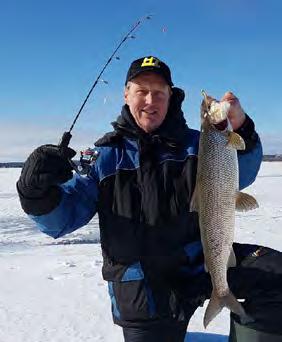

Lake Trout: Although almost considered an incidental catch while whitefish fishing, lakers in Simcoe are big and prime candidates for catch, photo & release. This species has not had a successful spawn in decades and even stocked trout are scarce, hence the reason anglers only see large mature fish.

trick even the oldest and weariest lake trout. Northern Lake Simcoe... may be one of the last parts of the lake to freeze because this section is deep and fully exposed to strong winds but it is still one of the best for both lake trout and whitefish. Look for lakers anywhere in the water column as they are opportunistic feeders that may be glued to bottom
very close to bottom. Lil Foxee Jigging Monnow’s, tipped with a small grub or crappie sized tube jig is a perfect presentation for Simcoe’s gobyeating whities that often roam in small pods with individuals not overly hungry – almost like fussy eaters willing to grab one last little tidbit before they’re really stuffed. This is when I dig into my perch arsenal and grab an HT Tungsten Marmooska tipped with their Ice Scentz or other micro grub. Whether you are trying this or the Foxee Jig just be sure not to overwork them and jig right on bottom. For the occasions when whitefish are on the food bag – like early mornings... give the Rapala V Blades a good workout.
Yellow Perch: Like many others, I still spend more time on the ice every winter pursuing Simcoe’s famed jumbo’s than all other species combined. HT’s Tungsten Marmooska jigs tipped with their Ice Scentz grubs are perfect when these tasty panfish become finicky... and they often are!
Just Fishing . 18 Winter 2023
on page 20.)
(Continued


6:Consider partnering with a local motel or another accommodation provider to offer a package plan that includes accommodations and rental of your ice hut.

7:“Bring in the Pro’s” for ice fishing seminars! They can cover the basics, indepth techniques that work in the local area, tackle and ice safety.



8:Partner with each other. If you have a good working relationship with one particular tackle shop owner... see if the local hut operator would provide discount card/coupons for tackle in his/her shop in exchange for a discounted ice rental price.













SCOPING OUT SAFE ICE BEFORE YOU SET FOOT ON IT
Local ice hut operators or bait & tackle shops are usually the experts to contact to find out about local conditions across the province. Various on-line fishing forums and social media pages have also become popular as a primary source of information. This can be both good and bad.

Responsible sources like the Lake Simcoe Message Board for instance allow their highly respected spokesperson John Whyte to post up-to-date video clips that often utilize drones to show hazards and on-ice thickness/ quality tests. This is far more responsible than someone using a pseudonym posting Lake X is safe to fish because he and some friends had 5 inches when they went yesterday.
It’s important that before you go, regardless of when or where you are ice fishing, always let someone know the destination of your fishing area, the spot you are accessing the lake and when you plan on returning home. As well as your trusty GPS, It also helps to carry a compass, and know how to use it should your batteries fail and a snowstorm leaves you guessing which way shore is.
Most importantly always carry a set of ice picks with you and have them readily accessible via a draw string around your neck or in an upper arm pocket of your coat. I have tried several brands over the years, and the ones by HT with retractable picks that don’t jab or poke you in transit, are my favourite.
I look at carrying ice picks as inexpensive insurance that you never want to cash in on, but great to have at the ready if ya gotta! Carrying ice picks is like wearing your seat belt... you don’t ever want to have to rely on either to save your life... but just in case – each of them can and will!
WALKING ON HARD WATER
Ice never freezes uniformly so testing it with a spud bar or auger frequently when unsure
Just Fishing . 22 Winter 2023
(Lake Simcoe on Ice continued from page 20.) (Continued on page 24.) Just Fishing . 50 Fall 2021 YOUR PREMIERE FISHING & HUNTING DESTINATION
Crossbows & Accessories – Bass, Walleye & Musky Tackle, ICE SHELTERS
Clam Otter & Eskimo – BOOTS for the Entire Family
Bogs, Irish Setter & More by HUK, Under Armour & More – 100’s of GIFT ITEMS & HOME DECOR, LIVE BAIT & SO MUCH MORE... 7811 Hwy. 15 (Just south of Carleton Place) (613) 253-FISH (3474) | www.baitcasters.ca UPCOMING EVENTS • Archery Sale – Sept. 29-Oct. 3 • Annual Boot Sale – Oct. 14-17 • Hunting Sale – Oct. 28-31 YOUR ICE FISHING HEADQUARTERS! – LIVE BAIT
FOR: Excaliur
By
by

is standard practice on your way out. I like HT’s heavy duty Siberian spud bar that will chomp through ice lickety split. As a rule, at the start of the season, ice will be of highest quality and thickest near shore but the further you walk out the thinner it will become; so test often. When there’s glare ice HT’s ice safety treads slide over your boots easily and will help you stay upright and avoid nasty falls. If you’re fishing new lakes or even new sections of lakes you may not know conditions that well so test as you go! Try to identify and avoid any safety hazards like pressure cracks, air bubblers, river mouths, springs or currents – like those often seen in neckdown areas of Couchiching.
Crayfish profiles are outstanding as well. Use heavier sinkers to penetrate thicker weed cover where needed.
bass inhabiting particular weed clumps or areas of weed beds. Pitch one out, let it settle, hop it a few times, and repeat. It may be what’s needed to tempt less active bass to bite. Remember, the cooler the water, the more heavily bass tend to be schooled. Don’t leave a good spot before trying additional tactics to trigger strikes.
As a general guideline, four inches of clear blue or black ice is required for a person on foot. Anglers should still spread out however and be extra cautious because they might find that magic four inches in one location... but only two, somewhere else. Find at least six – eight inches of good clear blue/black ice for a snowmobile or ATV. Double the thickness if any ice that is white or opaque to equal the strength of the blue/black ice. Later in the season, ice can become soft or even honeycombed or candled and should be avoided. Additionally, that ice near shore, especially on northern shorelines where intense late winter sun can take its toll, can be troublesome... so be aware. Heavily used on-ice access spots are also problematic. Every late winter we can be fishing on over two or three feet of real good ice far from shore but those shoreline spots can be nothing short of treacherous so always have an alternate site to get off somewhere other than your primary access site at the start of the day.
MID TO LATE FALL
Once surface water temperatures dip below 50o F, much of the shallow lily pads, inside weed edges and the shallowest portions of weed flats tend to become devoid of bass. Dying weeds give off noxious gases rather than oxygen. By this time, largemouth bass are well into their shift toward deeper weedgrowth, likely inhabiting mid-depth weed flats and the deep outer rim of weeds. This doesn’t all happen overnight, however; it’s a transition. But the later in the season, the more the odds go to fishing the outer weed edges and immediately adjacent weeds on the deep flats.
When good ice conditions are present, traveling and ice fishing on frozen water can be extremely safe and enjoyable. In a lot of respects, ice safety is just a matter of common sense. Rest assured that going through is almost always preventable and prevention is always your main goal. Ultimately, learning as much as you can about this topic and experiencing different conditions on different lakes, at different periods during the winter will help you become more confident in your abilities to develop a healthy respect and understanding of the ice that is keeping you from becoming intimate with all that icy cold water and of course the wonderful fish beneath you.
Weedless jigs tipped with large softbait trailers become your primary bass catchers at this time. Station your boat in deeper water just off the deep weed edge and pitch your lure somewhat up and into the outer bands of weeds.



Here’s to a wonderful and safe ice fishing season for everyone visiting Orillia Lakes Country this winter!

Let it settle, pause and feel for a twitch or heaviness – or a jolt – that indicates a bite. If not, lift the rod tip to see if you can slither it a bit through the weeds, then allow it to drop again. If it won’t move,



A 1/2- to 3/4-ounce weedless jig dressed with a large soft plastic trailer provides a real mouthful for greedy mid- to late-fall largemouths. Black, black-blue and brown-orange are traditional colour favourites.
Editor’sNote: Wil Wegman s an award winning outdoor writer appearing in many Canadian & US Outdoor magazines. He is an avid ice anglers who was a member of Canada’s National Team at the World Ice Fishing Championships. He has won the Lake Simcoe Perch Attack & the Perchin for MS Event. In 2017 Wil was inducted into the Canadian Angler Hall of Fame & won the National Recreational Fisheries Award & the Rick Morgan Professional Conservation Award. He can be reached at his Focus on Fishing site at www.wilwegman.com.



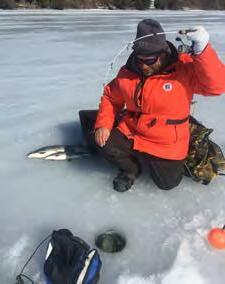
Just Fishing . 24 Winter 2023
(Lake Simcoe on Ice continued from page 22.) Just Fishing . 12 Fall 2022
(Fall Largemouth on the Prowl continued from page 10)
13.)
(Continued on page
Once bass are located, pitchin’
a
Texas-rigged tube bait tempts less-aggressive bass to bite amidst weed clumps on the flats.

shimmering bait. Moments later I’m holding the chunky fish for a photo before releasing it back down the hole.
This evening is one of many where using a flashy lure proves key for catching walleye. In my experience, baits with flash, glimmer, sparkle, reflection – whatever you want to call it – have a special appeal to wintertime walleye. Here’s a closer look at why I’m a fan of flashy baits and how to use them to hook more walleye in winter.
FLASH GRABS THEIR ATTENTION
Much of an ice angler’s success hinges on being able to attract walleye. We don’t have


Another reason flashy baits are effective in winter is the water is often clearer than during the open-water season. Ice cover eliminates the turbulence of wind and waves, and there’s less turbidity in winter. Given this, light reflected from a jigging spoon, for instance, travels a good ways. And, when you combine this with a walleye’s superior low-light vision, it’s no surprise that flashy lures are deadly at attracting fish and triggering strikes. Even faint flickers in dark water appeal to walleye.
On one memorable outing, several friends and I were exploring a new lake for walleye. We fished several mid-lake structures and

Metallic Finish Options
When it comes to choosing a finish, gold and silver are the two most popular picks of the flash-bait game. There’s a theory that silver is best in bright, sunny conditions and that gold (and copper) are better when it’s overcast and during low light. Don’t get hung-up on these guidelines, though. Experiment and let the fish tell you what they want.
There’s also a case to be made about not just owning smooth-sided gold and silver spoons, but also owning lures with a hammered finish. These dimple-stamped metal baits


Just Fishing . 26 Winter 2023
(Continued on page 28.)
A Rapala Rippin’ Rap in a Gold Chrome Finish Landed this Golden Girl.
Genuine 24K Gold Plated Williams Ice Jig

reflect light from multiple angles and mimic the scales of baitfish.
Williams Nuwrinkle pattern is one example.
which have a highly reflective holographic baitfish finish on one side. Recently, I’ve also had good success with a VMC Rattle Spoon, which also is available in shiny holographic finishes.
Multi-Coloured Baits
In addition to gold, silver, and copper, there are other flashy colour options. Multi-coloured baits, make it easy to experiment with different finishes to learn what sheen is best for the day. Prism and other holographic tape make it easy to customize baits and boost flash appeal.
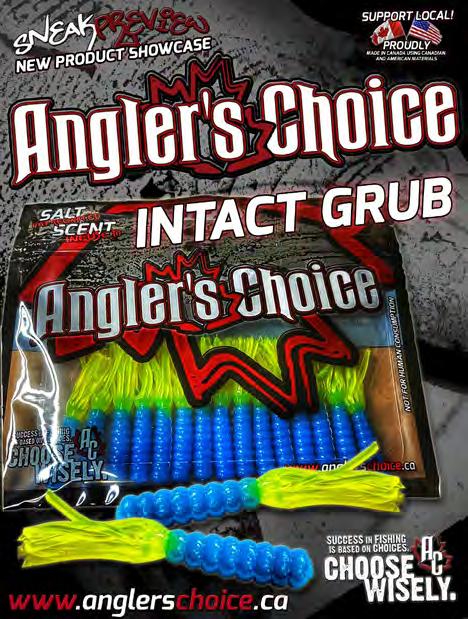
There’s also the growing trend of more sophisticated, multi-coloured finishes. From ultra-realistic baitfish to neon bright hues, there’s no shortage of options for anglers keen on a colourful, glimmering bait.
Rattle Spoons with Flash
One of my most consistent ice-fishing lures for walleye is a Northland Buck-Shot Rattle Spoon. I use several colour patterns, many of

Many of these spoons come in patterns with a reflective finish on one side and then glow paint on the other. I am a big believer in glow baits for walleye. The added luminescence of glow combined with metallic flash and rattles are three reasons why these style of spoons are deadly at fooling walleye.
Flutter Meets Flash
Non-rattling, shiny spoons also appeal to walleye. Flutter spoons continue to be popular for walleye. Flutter spoons represent a large category of baits. Anglers like my buddy Alex Keszler, use thin, salmon spoons, like the Luhr-Jensen Coyote and Blue Fox Matrix, to cover water and catch big walleye roaming flats. “Flash can pay big dividends in a day,” Keszler told me once. “Do not use a thick spoon. You need it to be thin for the side-to-side, slow fluttering.”
Other high-action spoons that flutter are the Custom Jigs and Spins Slender Spoon, Mepps Syclops Lite, Buck-Shot Flutter Spoon, VMC Tumbler, and many Williams models. These spoons sway when lifted, then slowly sink with a horizontal, fluttering action. Add a reflective finish and you’ve got a lure with a serious strobe light effect walleye can’t resist.
Another reason these spoons are effective is because their actions are rather distinct compared to other popular presentations, like jigging minnows, lipless crankbaits, and straight spoons. High-flash, flutter spoons give pressured walleye something a little more unique to look at and can turn sniffers into biters.
Shimmering Slabs
Slab-style spoons are another category worth mentioning here. Lure’s like the Luhr Jensen Cast Champ, Northland Macho Minnow, and VMC Flash Champ feature beveled edges, which make them fall erratically, flashing all the way down and mimicking an injured baitfish.
The Macho Minnow also has a small, triangular tail, which kicks and flickers on the split ring. When an onlooking walleye is scrutinizing the bait a light shake of the rod is all it takes to make the tail move and flicker like a panicking minnow.


Amplifying Flash On The Fall
Letting a spoon fall on slack or semi-slack line can help maximize its flash. A long leash, so to speak, gives a spoon the freedom to tumble and shimmy, creating a glimmering effect. Letting one fall on semi-taut line will still reflect light, but it may not be as enticing of a visual. Generally, high-action flutter spoons need more slack
Just Fishing . 28 Winter 2023
(Continued on page 30.)
(Using
Glittering Baits for Golden Walleye continued from page 26.)
Caught with a Northland Buck-Shot Rattle Spoon
Perch Coloured Rapala Jigging Rap
Bass’n Bait Rattle Snakie Spoon Landed this Beauty


















2411 Barton St. E. Hamilton, ON Phone: (905) 573-2288 or 1-888-258-0564
than a straight spoon. Watch a lure’s action while jigging it just beneath the ice to learn what works best for specific baits.



The above said, remember to follow the lure down with the rod tip, keeping a slight bow in the line, to keep aware of how the bait’s behaving. More specifically, being able to detect a strike as well as know when a lure touches bottom.
Minnow Lookalike Considerations




As mentioned at the opening of this article, flashy horizontal lures are deadly for walleye. I have a hard time putting a Rippin’ Rap down when I want to cover water, attract fish, and trigger reaction strikes. In addition to the gold model, I’ve also had success with a few of Rapala’s new custom colours, like Fruit Bowl and Leprechaun, which feature various coloured metallic accents.

Walleye also love metallic jigging minnow. A chrome-blue Rapala Jigging Rap is a reliable choice when walleye are foraging on silvery sided baitfish, like ciscoe and smelt. There’s also something about a gold-olive Rapala Snap Rap that makes big walleye get hungry.
JIGGING TIPS FOR GLIDING JIGS


The inherent action of a jigging minnow produces a decent amount of flash. Begin with a large lift. Next, follow the lure down with the rod tip, giving it slack line so it can glide down and to the side, imitating a wounded baitfish. Pause to let the lure swim back to centre and come to rest. This final sequence creates subtle flickers like light reflecting off the scales of a baitfish and entices strikes.
How a lipless crankbait performs on the fall varies. Some baits do well on a semislack fall. The tall-bodied Rippin’ Rap is a little different. I find it’s best lowered on almost a tight line (e.g., controlled slack). Full slack can result in it kicking sideways and its hooks tangling in the line. You’ll need to experiment to learn what produces the best action and desired flashing effect.
Jigging minnows and crankbaits all trigger bites from walleye when shaken in place. The trick is not overdoing it. Just jiggle the hand enough to make the bait kick back and forth with a panicky, vulnerable, and flashing action to stimulate walleye to bite.

HANG A BAIT LIKE A MIRRORBALL


Here’s a final tip on ice-fishing a flashy bait – jig it several feet off bottom so more fish can see it. Doing this also gets the bait in the strike zone of active walleye, which often cruise several feet off bottom when they’re interested in feeding.
How high off bottom to jig a bait depends on the scenario. As a starting point, I typically start jigging a flashy bait with the intent to cover two to eight feet off bottom. This isn’t done all at once, of course, but rather incrementally by working the lure up and down in stages to cover different depths within the water column.
Admittedly, there are times when fishing tight to the floor catches walleye. I also won’t argue about the effectiveness of attracting walleye by banging a bait into a soft-bottom to create a silt cloud or hitting it against rock to make noise. Just don’t linger down low too long when looking to maximize the fish-catching appeal of a glittery lure.
This winter be sure your tackle collection includes some flashy lures. Glimmering baits do an excellent job attracting walleye and triggering them to strike. After all, a flickering lure does an excellent job portraying a baitfish, which is certainly an ace up your sleeve when fishing for predators like walleye.



Editor’s Note:
Tim Allard of Ottawa, Ontario is a hard-water expert and author / photographer of the multi-award winning book, ICE FISHING –The Ultimate Guide, available at fine book stores, select outdoor shops & internet retailers.


Just Fishing . 30 Winter 2023
Available at Fine Tackle stores or check out online store at: www.magzmfg.com HOME OF THE ORIGINAL "BADD BOYZ" JIGGING LURE
Motor
Pumpkin
Simcoe
Watermelon
White NEW 2” & 3” MAGZ GOBY Brown Chartreuse Globy Sand NEW for 2022 4 new colours for the BB3 & BB2 Badd Boyz Lures, available in our Holographic finish with 3 D eyes & UV Finish. Hand Poured in Barrie ON Goby Glow Holographic Natural Shiner Holographic Smelt Glow Holographic
Holographic (Using Glittering Baits for Golden Walleye continued from page 28.)
The Magz Goby offers a realistic goby baitfish appearance & action to entice even the most finicky fish. The soft body and active tail brings the original Magz Goby to life!
Oil
Brown
Sand Smoke
Green
Tenessee
Shad
Hooked on a VMC Rattle Spoon in a Glow Red Finish
Preheat oven to 4000f.
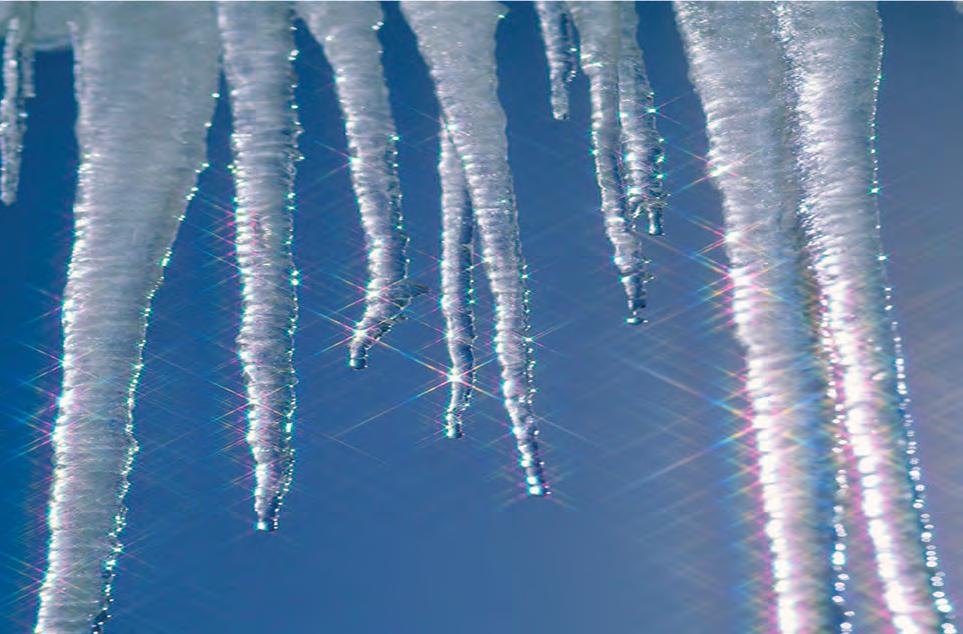
For the Love of COOKING COOKING
One of the greatest characteristics of walleye is that it can take on many flavours and presentation styles. Simple and common ingredients like garlic, spinach, onion, bacon, and parmesan cheese makes for a perfect marriage of flavours.

As most people can attest, side bacon has a rich, fatty, smokey flavour. In this case the bacon can be topped to the dish raw as stated in the recipe or “par-cooked” to eliminate excess fattiness.
This recipe is easily doubled, which is probably a good thing b ecause people will be wanting more than just one helping!:)
WALLEYE ROCKEFELLER
Yield: 2 Servings
INGREDIENTS:
60ml Butter
2 Garlic Cloves, finely chopped

140gram (1 package) Fresh Spinach
160ml (1 cup) Whipping Cream
Kosher Salt & Pepper
DIRECTIONS:
Heat frying pan on medium heat, add butter, garlic and spinach and wilt lightly. Add cream and seasoning, remove from heat and place into a small heatproof dish.

Slice walleye into half inch pieces and place on top of cooked spinach. Top evenly with sliced bacon and place in oven.
Bake for 15 minutes then top with parmesan cheese, bake for another 5 minutes, and serve immediately.
Happy Cooking!
Editor’s Note: Avid outdoors person, competitive angler, 2-time gold medal winning chef at the Culinary World Olympics and educator Cameron Tait truly loves being in the outdoors. Cameron is an active member of the Manitoba Wildlife Federation, Walleye Anglers Assoc. of Manitoba, Central Walleye Trail and on the Pro Staff team for Alumacraft / Suzuki and Minn Kota / Humminbird. When not pursuing his passion for the outdoors, Certified Chef du Cuisine Cameron can be found surrounded by mouth watering food.


8oz Walleye Fillets, bones removed
4 slices Bacon, thinly sliced
60ml Parmesan Cheese, grated or shaved


Just Fishing . 31 Winter 2023
with Cameron Tait
IN THE NEWS
Ottawa Boat and Outdoors Show Expands with 2023 Edition

Ottawa, ON – The Ottawa Boat Show returns with an expanded array of products. Join Ottawa’s top outdoor enthusiasts for an exciting kick-off to summer event. Formerly known as the “Ottawa Boat Show,” this year’s show brings along an impressive outdoor addition. The EY Centre will transform into the region’s largest boating and outdoor event.
The 2023 Ottawa Boat and Outdoors Show is set to showcase the latest boat models, fishing gear, powersports, paddle sports, accessories and more. Visitors can climb aboard marine models from some of the region’s top dealers:
“We are excited to unveil the new outdoor addition to the public,” said Scott Sprague,
OverlandNTH Helps Produce an Overlanding Pavilion at 75th Annual Sportsmen’s Show
Mississauga, ON – OverlandNTH and Toronto Sportsmen’s Show announce that the companies have entered into a working arrangement to expand the Toronto Sportsmen’s Shows offering into the growing Overlanding market, which has experienced significant growth following the pandemic.

“We are excited to be working with the OverlandNTH team as their expertise and leadership within the Overlanding community in Ontario is second to none.” says Mike Blakoe, Toronto Sportsmen’s Show Manager. “We look forward to educating the outdoor enthusiasts about overlanding and help them connect with various resources, manufactures and suppliers that are helping to build and grow this exciting form of travel and lifestyle.”
Event Manager. “The expansion of the show has allowed us to bring in some unique features. This show has been a family favourite for over 4 decades, and we’re excited to be back after a long 2-year break.
Tickets for the event are currently available online. Online and at the door, admission is $16.00 per adult, $13.00 per senior or student and $35.00 for a family pass. Promotions fcan be found on our social media.
Special activities are planned throughout the event, and visitors should allot at least
a couple days to complete any shopping and enjoy the rest of the show. Families can look forward to activities geared toward the next generation, while fishing & boating enthusiastswon’t want to miss presentations from pro staff and seasoned experts from across the country. In addition, those visiting the show can enjoy free parking at the venue all weekend long!
For complete details, visit the show’s website at www.OttawaBoatShow.ca and connect with the show on Facebook & Instagram.
Customers of The Toronto Sportsmen’s Show will now be able to see the various types of vehicles used when overlanding and learn how manufacturers are helping to make life on the road more enjoyable, while making your vehicle capable of getting to that remote destination. The Toronto Sportsmen’s Show is one of Canada’s most recognized events for all things boating, hunting, fishing, camping and much more.
Luke Nixon-Janssen, Managing Partner, OverlandNTH said, “We are excited about having the opportunity to share our passion for overlanding with attendees of the Sportsmen’s Show and we can’t wait to
share with them what overlanding is all about. The arrangement also provides the opportunity to promote OverlandNTH events, while working with the Toronto Sportsmen’s Show to expand on their offering for the outdoor enthusiasts. Attendees will enjoy an activation that allows them the chance to see various styles of vehicles used by overlanders on their adventures and how it is they can then incorporate and learn from knowledge gained and shared.”
For complete show details, visit the show’s website www.torontosportshow.ca or find the show on Facebook & Instagram.
(Continued on page 33.)

Just Fishing . 32 Winter 2023
Ontario Supports Environmental Action in Peterborough to Continue Protecting
& Restoring the Great Lakes
TThe Ontario government is investing $22,876.00 in The Mysterysnail Management and Removal Project through the Great Lakes Local Action Fund that will help build healthier communities while protecting and improving the health of the Great Lakes and their connecting waters.
The Ontario Federation of Anglers and Hunters’ (OFAH) with the Invading Species Awareness Program (ISAP) works to reduce impacts of aquatic invasive species, including Chinese and banded mysterysnails. In 2021, the Mysterysnail Management and Removal Program was launched by ISAP alongside community partners, such as the Coalition of Haliburton Property Owners’ Association. To date, the program has removed over 675,000 mysterysnails from local lakes in the Lake Ontario watershed. Building on this success, the ISAP will continue to engage volunteers and community groups with training, tools, and on-the-ground support needed to coordinate mysterysnail removal events within their communities in the Lake Ontario watershed.
“We are proud to be supporting the Ontario Federation of Anglers and Hunters’ Great Lakes project. With support from the Great Lakes Local Action Fund and the help of volunteers, the non-profit organization is working to remove
the mysterysnail, an invasive species throughout the Lake Ontario watershed,” said David Piccini, Minister of the Environment, Conservation and Parks. “By working together, and investing in community projects like this one, we will continue protecting Ontario’s Great Lakes for future generations.”
“Once again, the OFAH is pleased to partner with the province to empower local communities and volunteers working to combat invasive mysterysnails” says Angelo Lombardo, OFAH Executive Director. “Taking a proactive approach to

remove and manage invasive species, like mysterysnails, can result in longterm benefits to biodiversity and the quality of recreational activities that all Ontarians enjoy.”
This project is one of 38 communitybased projects to receive $1.9 million in funding from the Great Lakes Local Action Fund.
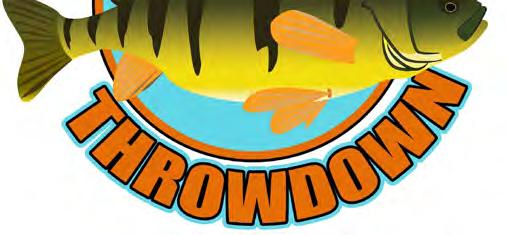
For more information, visit: http://www.invadingspecies.com/invaders/ invertebrates/invasive-snails-2/








Just Fishing . 33 Winter 2023 (In The News continued from page 32.)
A Lake Simcoe specific ice fishing tournament on FISH DONKEY! Win cash as well as lots of draw prizes! For the latest updates, like & follow us on: Sat. Jan. 21st through Sun. Feb. 26th, 2023 Contact us for more details: Lake Simcoe JUMBO Throwdown lakesimcoejumbothrowdown@gmail.com
INVASIVE
INVASIVE Banded Mysterysnails INVASIVE The Channeled Apple Snail INVASIVE New Zealand Mudsnail
Chinese Mysterysnails
By: Matt Johnson – Ice Team Manager & Guide

WWhen one thinks about ice fishing, they typically picture walleyes, crappies, sunfish, perch, pike, maybe even a lake trout or eelpout, but not many people think of catfish. Even the mere idea of catching a catfish under the ice results in scowls – sometimes even laughter. But for those of you who venture out chasing these whiskered critters, you’ll find yourselves smack-dab in the middle of not only an incredible tussle, but also one of the tastiest winter fish across the ice belt.
Before moving on with this article though, I want to stress the importance of safety. Current – or areas where current is nearby –make-up some of the following locational patterns. So please keep ice safety a top priority as you read the following locational tips for finding catfish.




So just where do these catfish spend their winter? As a general rule, catfish will locate in deeper water or areas where current catches their attention. These fish will hold in those deeper pockets, but I’ve also found them as shallow as five feet. It all depends on the body of water – so “deep” is relative. Shallower ponds and lakes will have catfish holding in the deepest parts – providing there aren’t areas where there is an influx of water. I prefer to target bodies of water that are connected to rivers or creeks/streams. Off-shoots from major rivers that pool into lakes and systems are excellent places to target as well. Finding catfish can be relatively easy if you just spend a few minutes studying a lake map before punching any holes, but here are a few ideas to narrow down your search...
In lakes/reservoirs with deep water, I like to search out for the “channel” and focus my search relating that. Now this does mean actually fishing the channel, but rather use that as a reference for where the catfish might be holding. Most of these reservoirs and lake systems have main channels where rivers (at one point) ran strong or might even continue to push current through them. These channel areas oftentimes create burrows along the bottom giving away to cuts and depressions where catfish gather for comfort.
Catfish rely heavily on their sense of smell and will move with current to grab the bait once detected. This is why we fish just upstream from snags during the open water months, so when a fish smells “what’s cooking,” they come out to take a taste. The scent travels downstream and pulls the fish out. While this doesn’t give you the end-all answer for winter catfish, it does give you a few more chances and can narrow the search when looking at a map –especially when deciding where to setup camp.
then you might have found yourself a gold mine. I typically expect to see fish stacked up in these situations and see these spots are their “wintering holes.”
Other areas of interest include spots where parts of a lake neckdown, causing current. Flats just adjacent to these areas will generally hold catfish, especially if those flats are deeper or even create a hole or depression of their own.
Some of my personal favourite spots to target winter catfish are holes along the main river (if ice is safe). Warning though, and to reiterate safety, as these spots rarely see more than a foot of ice so proceed with the utmost caution. Check the ice constantly and don’t make
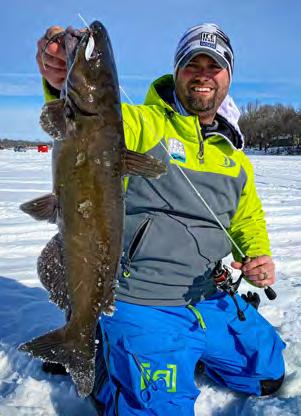
Just Fishing . 34 Winter 2023
(Continued on page 36.)
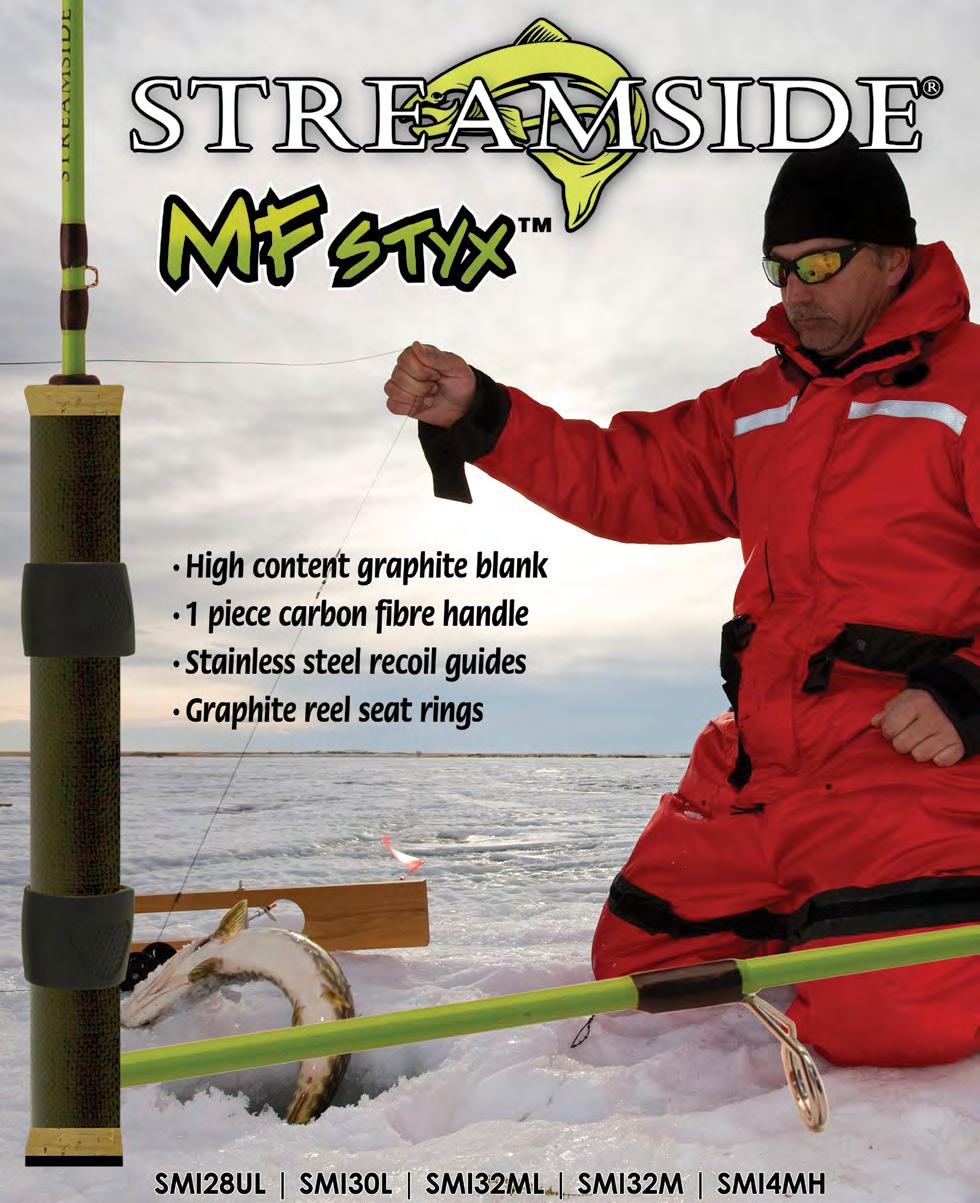
YOU are invited to come along for the ride…
(Catfish Play in the Snow Too! continued from page 34.) an attempt to target these spots at early ice. Leave these spots for mid-winter, as even during extreme winters we might still only see a few inches of ice over these areas because of current conditions. But if you are fortunate enough to take advantage of these situations, then the rewards can be great. Heavy spoons packed with pieces of minnow will do the trick and hold on – the fish seem to find you!
There are however, spots similar to the above mentioned holes that are along stretches of lakes where there is less current and safer ice – and you don’t have to always focus on current areas to catch catfish either. Lake systems that form off of rivers will present similar spots and can be fished just the same. In all actuality, if you can find spots off the main river that are pushed back into lake chains and backwaters, then you’re going to also find consistent action for fish of all sizes – not to mention much safer ice conditions. Many “lake spots” that we fish each winter see the same ice conditions that most of the lakes we fish on, and larger vehicle traffic, plowed roads, etc, all come into play as well.

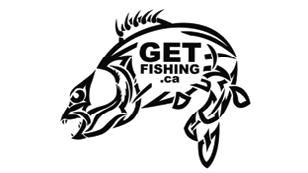
and the fish has to react by attacking it or letting it go. I now use crankbaits a lot more around home, particularly in tournament situations because of their ability to make contact with numbers of fish and attract bigger bass. Most of my crankbait fishing today is done with Bagley balsa crankbaits. Balsa – a type of wood, is a popular material also used by Rapala, because of its high buoyancy, which promotes the unique action that balsa baits have. They wiggle naturally and simply catch fish.
Around home, crankbaits shine around rocks. I am typically using them in shallower water, from four to twelve feet and choose my colour based on what I think the primary forage is. Around home that’s often crayfish but on waters where baitfish are the primary forage, I’m going to go with a natural shad colour.
Crankbaits do a great job of bouncing off of rocks, avoiding snags so they are great to use around snaggy areas and especially around


Presentations for these whiskered fish are simple... rely on scent as your main weapon and don’t think for a second that these fish won’t chase an active presentation. What I mean is, use multiple pieces of minnow and don’t be afraid to have the entrails hanging out, and then jig away! Don’t cut the minnows either, pinch them, it leaves what’s left on your hook a lot more enticing! Walleye anglers are supposed to be more sophisticated when attaching just a minnow head or tail, but for catfish, you just gob those babies on! However, there are times when just a small piece is all they want, but I oftentimes error on the side of excess and give them meat!
(Continued on page 34)
Just Fishing . 21
Just Fishing . 36 Winter 2023
Just Fishing . 26 Just Fishing . 32 Just Fishing . 32 Summer 2021 YOUTUBE.COM/MATITYSGETFISHING
IT!
‘Cuz Fishing’s Magic!”
& Jason Matity
our YouTube Channel & SUBSCRIBE for FREE!! THE BEST KEPT SECRET ON THE INTERNET
“IF IT SWIMS... WE FISH FOR IT... AND WILL HELP YOU CATCH
GetFishing
Jeff
Visit
FREE SUBSCRIPTION at: YouTube.com/matitysgetfishing
ALL Species...ALL Seasons... GET FISHING.CA has GOT IT!
(Bass Fishing cont. from page 30.)
Fall 2021
Jigging spoons are a great tool for these situations in my opinion. You can pack a treble hook and present a nice “bait ball” for the fish to grab onto. I always replace my trebles with a size larger and with a forged round-bend hook if possible. The catfish put a lot of abuse on your hooks and can straighten them out if you let them! Some of the spoons I really like are the Clam Pro Tackle Small Pea (replace the single hook with a treble hook), the Rattling Blade Spoon and the Leech Flutter Spoon. It’s a nice variety of options that fish differently. Otherwise a larger panfish jig like the Clam Pro Tackle Drop XXL packed with maggots or a piece of minnow can coax finicky catfish into biting as well. Fathead and crappie minnows are generally all you’ll need, so an easy find at most bait shops. I do bring some sucker minnows and cut them up for dead-sticking at times, too.
Techniques for getting these fish to bite can at times depend on their mood – much-like all species. Let your Vexilar be your fish’s mood indicator, and let it tell you what type of action they prefer. Oftentimes you won’t have kamikaze catfish, but rather light biters like we experience with our crappies at times. Subtle shakes and quivers will sometimes be more than enough, and then just watch your line once a fish appears over your bait! These fish are notorious for just sucking in the bait without anyone knowing, or “tasting” the bait with their whiskers. Spring bobbers and noodle rods definitely help, but by constantly moving you rod tip you can tell when a fish has the bait, as there will be an abrupt deadening of the rod tip. When that happens, you better set the hook into that whiskered cinderblock and get ready for a fight! Not to only focus on finesse though, I generally deploy a more aggressive jigging sequence to begin my day, and work down from there to find the desired results.

WATER You Waiting For?


Some of the rod choices I prefer are the Jason Mitchell Dead Meat or a medium power in the Dave Genz Legacy line-up. I also have a variety of custom rods from Thorne Brothers specifically built for catfish – yes, I know, we are wintertime catfish dorks! A soft tip is important, as these catfish are light-biters and you’ll need that to detect the bites some days. Then I pair these rods with a 1000 series size for a reel. The Dead Meat comes in a great combo as well. And then for line I use the Clam Frost Ice Line in 5-6# monofilament and away we go! So there are excellent over-the-counter rod options out there for targeting catfish, but feel free to have fun with it and have a custom rod built as well!
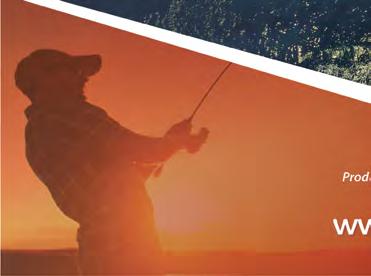

There’s no doubt that catfish can provide a lot of action and excitement out on the ice. And most areas across the ice belt have lakes nearby where catfish are abundant. Like all fish species though, practice selective harvest, as catfish can and will school-up in the winter, and over-harvesting can still take a toll on the catfish species. But if you do decide to take home some catfish for a meal, there is nothing better than a nice Cajun-battered catfish fillet from cold water!
Editor’s Note: Matt Johnson is a fishing guide in Central, MN and spends a lot of time chasing catfish through ice. For more informatiom, visit: www.MattJohnsonOutdoors.com.



Just Fishing . 37 Winter 2023
(Catfish Play in the Snow Too! continued from page 36.)
MARK
CALENDARS Thursday, Feb. 23 10am - 8pm Friday, Feb. 24 10am - 8pm Saturday, Feb. 25 10am - 6pm Sunday, Feb. 26 10am - 5pm
YOUR
Can Science Help to Cheaters in Fishing Tournaments?
By: Dr. Steven J. Cooke
AArecent high-profile case of cheating at a walleye tournament in Ohio is a good reminder that some individuals will bend or break rules (and laws) for personal gain. Although we would like to pretend such instances are rare, the “whisper” network reveals that suspicions abound. In reality, we have no clue about how much cheating really occurs.

fish species that can help to guide tournament organizers. For example, a largemouth bass that is, say 20”, is typically around 5 pounds. If a 20” fish weighed 7 pounds, one might question the observation. However, biology is all about variation so there are skinny fish and chubby fish for any given length.

that have been held given that the various things that happen to fish during a normal tournament day result in a wide range of stress responses. There is no magic blood test that can help.
Some event organizers are turning to lie detectors in an attempt to dissuade or nab cheaters. Others are turning to biologists for help. This is not new. I can recall being invited to be involved in tournament weighins for several decades. I also recall scouring a waterbody with mask and snorkel looking for fish held in cages. Although part of the justification of having me (or another biologist) at the tournament was to ensure that fish care was optimal, it was also understood that I was to keep an eye out for “fishy” business. Here I provide a candid take on what biologists can and cannot do to help identify cheaters at fishing tournaments.

The first form of cheating is manipulating the mass of fish. Weights can be inserted in the stomach. There are known lengthweight relationships that exist for different

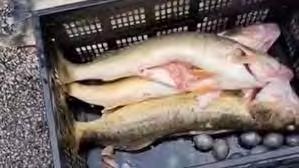
The last thing we want to do is kill and eviscerate every chubby trophy bass to see if it has any weights in its belly. The walleye case that we are all familiar with involved adding multiple large lead weights, which could potentially be detected by gently squeezing the belly. It is also possible to use an ultrasound to look for foreign bodies in a fish but those devices are expensive and require individuals with specialized training.
The second form of cheating involves catching fish in the days prior to the tournament and holding them until the day of the tournament. There are no robust stress markers that can be used to identify fish

However, external examination of the fish could provide some clues. Fish that have been held for extended periods may have frayed tails and fins or bruised snouts. However, those injuries are not entirely uncommon in other scenarios. Use of nets can fray fins and snouts can become bruised during livewell retention. So – nothing that is a smoking gun.
The third form of cheating involves catching fish in a different waterbody (presumably before the event) and then transporting them to the event waterbody and weighing in the fish. Everyone is familiar with DNA from crime TV series, which is definitely a tool that can be used to determine the origin of a given fish. However, doing so requires much background sampling to generate a reference profile of various waterbodies.
The more closely connected a waterbody (and thus potential for gene flow), the more




Just Fishing . 38 Winter 2023
(Continued on page 40.)

difficult it would be to use genetics to identify cheating. The lakes on the Rideau Canal and Trent-Severn Waterways are examples of where differentiating whether a bass was caught in Balsam Lake or Rice Lake with any certainty would be nearly impossible.
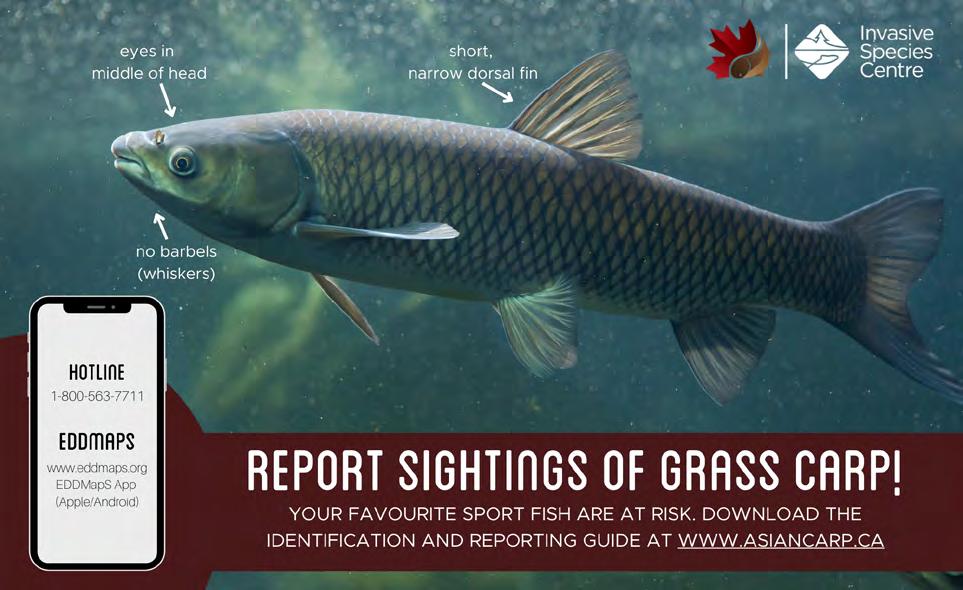
I can think of some specific examples of where genetics could work. For example, if a waterbody had been stocked with fish of a given (and unique) genetic pedigree (or with a specific genetic marker) and those fish were somehow showing up in a distant waterbody, that would be rather curious. However, the take home message is that genetics are unlikely to be sufficient to prove cheating in almost all cases without spending a small fortune in background genetic sampling.
It is problematic to drop accusations (potential for libel suits) without rather definitive proof. Unfortunately, most of the contemporary tools available to biologists are insufficient to provide proof that would be anywhere near definitive. Having given expert testimony in a court of law before, I am confident that most of the tools or approaches outlined above (aside from finding weights in the belly of a fish) would stand up to a legal challenge as being proof of cheating.
Quite simply, there is too much uncertainty. I love the fact that competitive angling event organizers work closely with biologists
but we need to be clear that their purpose is to improve fish care or to collect biological data and not to identify cheaters.
Do I see a future where that will change?

Unlikely... We already have access to incredible tools that provide information on fish health, condition and genetics but there are some practical realities that make it highly unlikely that they will be of great use in a forensic context for identifying cheaters!
So – Personal integrity and peer pressure to be an ethical and responsible angler coupled with the threat of a polygraph are about the best tools we have.

About the Author
Dr. Cooke is a professor of fish ecology at Carleton University (www.fecpl.ca). He is an avid angler and advises governments around the globe on fisheries management and conservation. He is also a Science Ambassador for #Keepemwet Fishing.
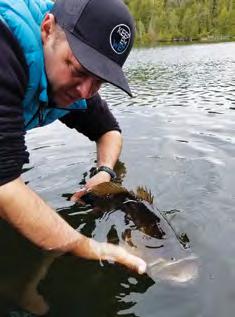
Just Fishing . 40 Winter 2023
(Can Science Help Identify Cheaters in Fishing Tournaments? continued from page 40.)

NNobody wants to be “that guy”… You know, the guy at the coffee shop that what he doesn’t know he makes up! As a biologist, fisheries professional and teacher I get the chance to talk fishing with people every day. When I run into “that guy”, an ardent armchair biologist, I must push back. Myths and misinformation sabotage the success of all anglers. In my experience, taller tales are told about burbot, eelpout or ‘pout for short, than any other species.
I enjoy the moniker, “Professor Pout” within our In-Fisherman family and take pride in learning more and more about this fish of amazing character each year. Truthfully, this freshwater member of the cod family, is incredibly complex. Crack the code on these beauties and you’ll be catching big fish and lots of ‘em!
In this article is the summary of what we at GetFishing.ca have learned over the past 20 years ice fishing for burbot. The learning and amazement continues.

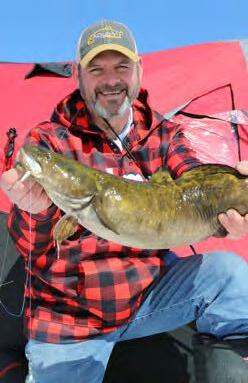


Myth Busting: Underrated Fish Slayer
Two persistent myths include the belief that pout are strictly bottom feeders that have poor vision, making them a less-weaponized predator than, say, pike. One study from Sweden, comparing pike and burbot predation on stocked char, laid waste to these myths.
Northern pike are arguably the top freshwater predator throughout the entire Northern Hemisphere. Too, the char in the study were suspended in open water. Surely, bottom-feeding, poorly sighted burbot would seem completely outclassed in this instance, right? Wrong! Shockingly, in this study, compared to the pike, burbot ate significantly more char. No explanation was given; but, I, personally, suspect the pike, visually oriented hunters, chased evasive char during the light of day while burbot out maneuvered disoriented char in the dark. The burbot could pull this off since they can hunt by
Speaking of sound, new to science is the discovery that burbot vocalize and “speak” to each other. The recorded vocalizations that I have hear on-line remind me, a bit, of the whir sound made by an object tied to a string then twirled, lasso-style, at various speeds to create rising and falling pitches of sound. Imagine if groups of burbot could vocalize an attack plan on a school of char. No one knows – maybe someday.
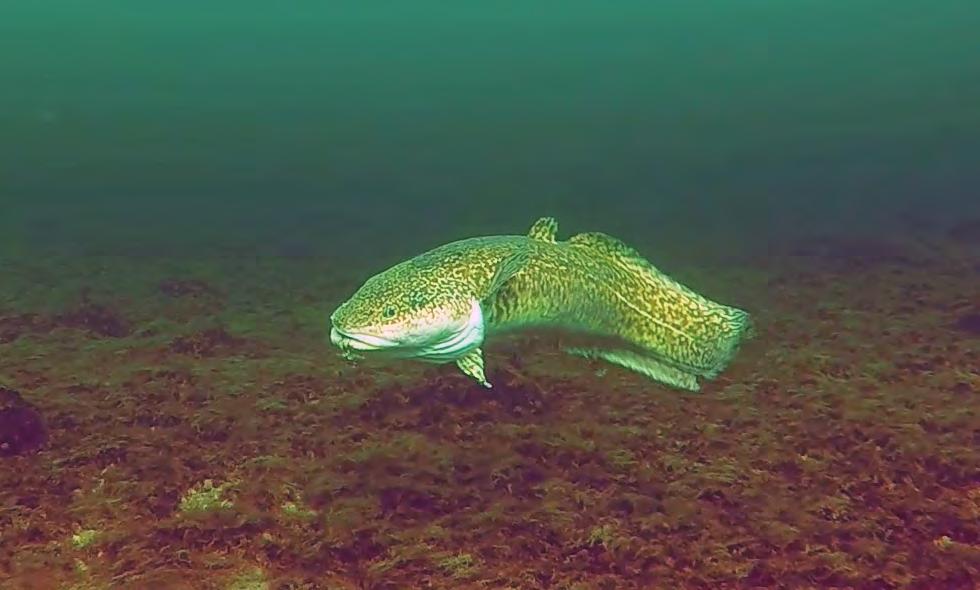
Celebrated History: Masters of Mille Lacs
“Grandfather taught me, when the wind begins to blow in February the fish are there.” These words from Ojibwa Tribal Elder, Leonard Sam of the Mille Lacs’ Nation during a phone interview several years back.


Inside a comfortable hut, Sam cuts a hole, 2 feet by 3 feet, over 3 to 5 feet of water having a rocky bottom. He uses a long handled spear and rubs the tines of the spear on the rocks to call fish. He is convinced the sound brings in the fish. “At first, a few fish appear,” he says. “Then more and more until there are so many they begin to gather in a writhing ball below the hole. I never take any females. These are all males and I take only what I can use.” Amazing, but most puzzling to me is that, upon cleaning, he determines them to be males?
Myth Busting: More Than Meets the Eye
After the Sam interview, I now keep detailed records of all of my harvested burbot. Over time, some facts emerged. The gonads of breeding males and females are enormous handfuls of either yellowybeige eggs or thick, white milt. Initially, there was a separate group of large, mature burbot that I struggled to clearly classify.
Just Fishing . 42 Winter 2023
(Continued on page 43.)
The Author Jeff Matity code name “PROFESSOR POUT!” LOL!
Jeff Matity with a nice burbot in front of his Eskimo tent.
I incorrectly categorized these burbot as spawned-out or immature males. Finally, it became clear that these big burbot couldn’t be spawned out males. This group were fullgrown fish, over 4 pounds. Baffling, their gonads were tiny, pinkish, ribbon-like, and under developed. Was this the group of fish that Sam also called males? I’m not sure; but, about 80 percent of the fish that son, Ben, and I harvested in 2008 were these, so called, “males”.
HHey fall trollers – water temps are finally starting to dip! Instead of tying on any ol’ crankbait, did you know you can use water temp to tell you which exact styles to run.
Dr. Vaughn Paragamian... Science Bridges the Gap


Brad Hawthorne’s logged a zillion hours pulling cranks in the fall, so it’s the first thing I asked him about when I had the chance to hop in his boat:
I sought out Dr. Vaughn Paragamian from the Idaho Fish & Game Department who had this to say: “Those fish are ‘nonbreeders’. Eelpout, like sturgeon, do not all spawn every year. Individuals rest on alternate spawning seasons.”


So why are resting fish active on the spawning grounds, I wondered?
He always starts early fall with #5 Rapala Shad Raps ‘cuz they’ve caught more fish than any other bait in his boat…especially while water temps are 60650F. Bump up to a #6 or #7 as temps reach the lower end of that scale.
Once the water hits 57-620F – and the weather is cooperating – he’ll put BIG ol’ bent-lip #9 Shallow Shad Raps. Everything is going shallow and putting the feedbag on, including perch this size….
“Eelpout rest only as far as gamete production is concerned. Unlike sturgeon that avoid spawning activity during their resting year, the entire eelpout population participates in the yearly spawn, in one form or another. Many males and females are mature non-spawning fish with underdeveloped gonads, easily mistaken as spent or immature males when cleaned. Only under a microscope slide, can oocytes be seen in the ovaries of females and spermatozoa in males,” revealed Paragamian.
During our conversation I shared that many of these non-breeders were very emaciated with sunken eyes, reduced girth and shrunken, pale-coloured livers. “Although an individual non-breeder will eat chum on bottom, for example, without any available food on the
Original Jointed Minnows are one of his favourite overlooked fall trolling baits when temps are in the 50-570F range and fish are on the chew. They run 5-7’ outta the package, but Brad will pinch on a small splitshot up above the bait to get ’em down to the 8-10’ range.
Frigid temps: Original Floaters are tough to beat. Brad’s caught fish on ’em in water as cold as 42 degrees. #PolarPlungeStatus More details straight from Mr. Fall Cranky himself in this video. (https://www. youtube.com/watch?v=RLYu8tPpv8U)
there, start fishing the sand. As the transition is getting underway, it’s still common to find walleyes
T This can be a frustrating time of year to track down a limit of tasties. Fish are on the move, but they’ll be migrating to predictable areas and eventually schooling up hard.
Ted Takasaki, Scott Richardson and Greg Bohn combined forces to give us and Yoda some fall-transition secrets. Full write-up archived here, few excerpts below:

“Baitfish will only stay in weeds as long as they’re very green. Once weeds start to die off... baitfish and walleyes start to leave those shallow-water weed areas.

spawning shoal, itself, these guardian fish fast for weeks and weeks, never leaving the eggs,” explained Paragamian.
How you set the hook depends on its size, diameter and thickness and when it is small, thin and razor sharp, a smart sweep of the rod tip is all that is required to nab every fish.

FISH FOR WHATEVER IS BITING
“They start to move out to more open-water areas at first... sliding out around deep water: sandbars that come out from shore and drop to deeper water, sand flats, sand points and sand
FLX-30 BB flasher/ fish finder featuring – 7 frequencies from 160 to 300 kHz, 140 interference rejection options, target ID down to 1/4”, Digital depth displat, Day & Night display settings, Battery status & low-battery alert, 3 power level settings & zoom zones. Plus Vexiar’s exc;usive broad band Ice-Ducer transducer & float, 12 volt, 9 amp-hour, Vexilar Lithium battery, fully automatic charger, Soft Pack carry case, adjustable rod holder, external power posts for accessories and a custom Vexilar tackle box. For more information,
I received a message from a reader last fall about catching big smallmouth, largemouth and northern pike. He had been unsuccessful in his efforts and asked if I’d help him zero in on the key depth. I flipped him back a note asking what species, in particular, he was targeting. He
Glo-Shot Spoons are a killer on crappies, perch, walleyes, pike and trout. Cast or vertically jig... the S-curve design and light, lead-free construction excels with twitches, lifts and falls.



“Walleyes begin to move deeper as water temps drop toward turnover . Instead of looking for fish to be on top of
Now, there is no question that when you are fishing for walleye, as case in point, that you may catch a bonus smallmouth, largemouth or northern pike. Maybe even several. But is it a huge mistake to assume it will happen and thus, go fishing without a specific species in mind.

“So, non-spawning guardian fish stay on the shoal, defend territory, and fast to the point of near starvation. Why?” I wondered out loud. “Well, why do most organisms on earth do outrageous things in the name of procreation?” retorted Paragamian. “One word: hormones. It’s primarily light and temperature, as well as other environmental cues that begin the cascade of hormones causing this behavior. There must be a mechanism by which they ‘know’ it is time to leave before their bodies give out completely. Bottom line, as long as the fat reserves in their liver hold up, they can stay.”
“They will be in spots like the sharper breaks or on mid-lake humps that top out at perhaps 20’, rather than 15’, or in holes in soft-bottom flats where depth drops from 15’ to 20’.
I use to accompany the Conservation Officers and fisheries technicians who worked for me and we would pull alongside anglers and do a creel survey. I was always amazed when the folks in the boats were asked what they were fishing for and they replied .... whatever bites.
Non-Breeders On Duty – More Bark Than Bite
Glo-Shot® Sticks boost fish attraction in low-visibility situations. Change Glo-Shot Stick colours to match conditions. Tip with live bait or IMPULSE® soft plastics. Glo-Shot Spoons are available in 1/16-, 1/8- and 1/4-ounce weights, with red treble hooks in #12, #10 and #8 sizes, respectively. Hooks are rings for added action and fewer lost fish. Sticks are non-toxic, easy to activate and glow in vivid colour for eight hours. They are light enough not to affect lure action and are also great for lighting up a variety of bobbers, hooks and jigs.
Finally, knowing the purpose of non-breeders’ presence - territorial egg guarding – explains why, as individuals or as a mob, they shun every living creature that dares invade their claim. Ciscoes are their primary antagonist, the target of the non-breeders’ disdain and fury.
“Walleyes become more selective about where they stage. They generally locate on a spot-on-a-spot. For example, if they’re on a mid-lake hump with scattered boulders, they will be on the boulders. If all rock, look for the patch of sand. If all sand, look for the rockpile.
To be successful, you have to focus in on a specific species, learn as much as possible about its lifestyle, habits, behaviour and seasonal preferences. Then you need to use the information to select prime locations, the best lures and optimal presentations. To do otherwise is to take a shot in the dark, which almost always misses the mark. Leave the hail Mary passes to the last minute desperation plays for
“Because more and more walleyes show up on these few spots, more and more of the lake holds no fish. It’s easy to be skunked if you don’t pay attention to subtle differences on the structure.”
Stakeouts with my AQUA-VU revealed ciscoes making forays to the bottom to gobble up eggs and then retreat, vertically, to just below the ice. When so incensed, frenzied ciscoes will attack lake trout- sized jigs. On a united front basis, the burbot chase allcomers away from the bottom. But, because they won’t leave their eggs, they won’t chase vertically. This makes the ciscoes’ game plan nearly perfect and their siege is relentless.
from Northland brings the noise with a glass rattle and audible carry through water, all without killing its famous action. Anglers have long noted the benefits of vibration and additional sound in their baits, as fish cue on auditory clues to both help them locate and target prey of all kinds. The Rattlin’ Puppet Minnow still sports its trademark action, darting and swimming like a dying minnow, which triggers
I will never forget interviewing Kevin Van Dam, the winningest angler in bass fishing history, immediately prior to one of his four Bassmaster Classic victories. He had sequestered himself, miles away from the tournament venue, at his brother-in-law’s house. When I asked him To avoid the dock talk.”
(Continued on page 44.)
Fishing
Hunting
Just Fishing . 43
Just Fishing . 53 www.targetwalleye.com –Consider signing up to receive FREE Target Walleye/Ice emails
MANOTICK BAIT 1019 River Road Manotick, ON (613) 692-LINE (5463) info: manotickbaitsupplies@hotmail.ca • Wide Selection of Tackle
/
• Bam Custom Plastics • “Big” Jim’s Hand-tied Bucktail Jigs HOURS: MON. – FRI. 8 AM – 7 PM SAT. & SUN. 8 AM – 6 PM We have worms & all sizes of Rideau River Fishing Headquarters The Store Where You’re #1 BASE YOUR FALL CRANKS ON WATER TEMPERATURE 3 FALL WALLEYES
4
LOVE SAND
(What’s Hot On Ice continued from page 37.)
Northland Glo-Shot
Northland Rattlin’ Puppet Minnow
(Burbot Beyond Belief continued from page 42.)
All walleye 20” or over are sexually mature. He puts every big mature fish back! Likewise, there is no fishing beyond 30 feet deep to reduce barotrauma on all released fish. Finally, single hook lures are employed whenever possible. Rob’s guides adhere to this high standard.
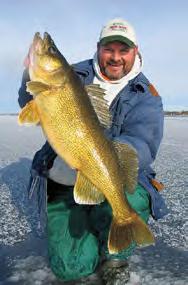
PADDLETALES
Parting words from the Magnificent One…
Watching my AQUA-VU always helps me connect the dots and turn difficult fish into predictable ones. Using the DVR feature on my HD unit, I record and then review, sometimes in slow-motion, how burbot approach and react. I now know that the intention of non-breeders is not to wolfdown food items in their path as breeders often will.
Eastern
We’ve discovered, like catfish, burbot have a sweet-tooth for fresh-cut baits. My all-time favourite is cut ciscoe belly (make sure it is legal where you fish)

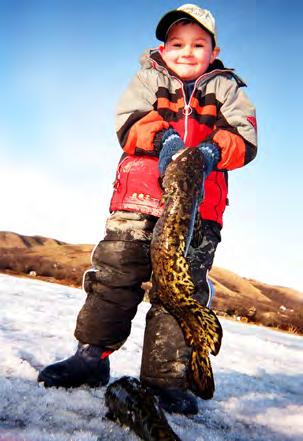
THURSDAY EVENINGS
Come Out Thursday Evenings & Share
“A fish-of-a-lifetime is an old but, still, sexually-prime fish. It is invaluable broodstock with superior genetics... (It is) way too valuable to be caught only once. You wanna be a pro? Carefully release all mature fish properly and be respectful... That means leave deep water fish
Alone! Kill a big walleye today and sacrifice the thrill of tomorrow.”
CUSTOMER APPRECIATION DAY WINTER HOURS
My discussion with Leonard Sam led me to believe, and discover, sound is the primary attracting factor for burbot. We use our heaviest, noisiest lures. Standard fare are 3/4 oz. and 1 oz. ReelBait Flasher jigs, as well as, sturdy 1 1/8 oz. Blue Fox Lil’Foxee Minnow jigs baited with cut ciscoe belly.

Your Favourite Fish Stories. Check Out the New Tackle. Enjoy Refreshments & Snacks.
About the Author:
Jeff Matitdy
A Fishing Industry Professional for nearly 30 years as a Fishing Guide & Promotional Staffer, with Bachelor’s Degrees in both Science & Education, Jeff uses this training in his job as a Fisheries Professional & Outdoor Educator (specializing in fishing via family business, GetFishing.ca) to reach out to anyone interested in learning about fish.
For example, while presenting a jig near bottom, a non-breeder will suddenly appear from off-screen and do a “fly-by” near the bait only to return, seconds later, to do another fly-by from a different angle and perhaps add a pectoral “fin tap” to the jig. My original instinct was to dance the jig to trigger a bite. But the burbot would come within 6 inches of it, stand on its nose menacingly, spreadeagle, fan its pectoral fins then leave. Other times it would belly-sweep the bait and push it into the bottom. If the burbot becomes fully committed to removing the invader, it will

Register @ paddletales.com to receive monthly specials.

A Closer Look: Fin Tap & Belly Sweeping
Effective Oct. 1 – April 1: Sun & Mon – Closed
Tues, Wed, Fri & Sat: 9:00 – 6:00
Thurs: 9:00 – 8:00
your rod a jolt to rip the weeds that might have got caught on a blade. A bait casting reel with a high gear ratio will allow you to reel in quickly to trigger a bite but also to take up the slack when smallmouth decide that the battle is on!
If we look at the long history of commercial and recreational fisheries in North America, there is another important lesson that is relevant to this discussion. Many of the most famous stories in this history are about great fisheries that were lost because we believed that “no strong evidence for a problem” meant that there was no problem. Fortunately, we’re starting to learn that this isn’t the best way to manage and conserve fisheries.
Putting It All Together
Start trolling by first watching the spoonfly rig at boat side to check that it’s running properly. This also gives you clues on the setup’s speed limitations. After gathering this data and you’re confident the rig’s running right, slowly let out line.
As described, a burbot’s fin tap and belly-sweep are aggressive, full-contact maneuvers in response to bottom-oriented baits. Now, during such stand-offs, I raise and hold my jigs a couple feet off bottom. The fish has only one body part to investigate the lure – its kisser! WHAMMO! This pattern is deadly and is the way to convert a “drive-by” into a “riser”. Simply hover the bait high and abandon the bottom once a fish has become engaged.
Pushing the envelope further, we’ve abandoned hook-baits for attraction and have moved to full-decoy lures. The Bondy Bait 4.4 oz. Mini Wobbler enrages with its size, flash and vibration. Burbot come out of the woodwork to fin clip and belly sweep this pugnacious intruder. The back-up to the Bondy is a 3-4 oz bell sinker, drop-shot set-up with a cutbait or scented plastic minnow rigged on a 3/0 hook set 30” above the weight. Pound the sinker until a burbot shows up. Then, sinker stationary, tease the bait above the fish.
Once a smallmouth strikes, you can usually tell when the blades stop turning. Always keep a firm grip on you rod, the strikes are vicious. Before setting the hook, I’ll take up the slack quickly allowing the rod to load up and then I’ll pull back on the fish. The days of slack-line setting are dead! Not only do you lose fish, but you run the risk of breaking your line from a powerful hook-set.
of the otolith from one of these fish that we interpreted as 15 years old. The other two fish were 16 and 12 years old. The point here is that many of the really big fish in these populations are old. In fact, we are only now coming to the end of the first generation of smallmouth that have been eating round gobies for most of their lives.
Preserving Our Precious Pout: Apples & Oranges
Let the rig sink slowly so that it doesn’t get tangled. One trick to help with this is feeding out one arm length of line at a time. This also gives you an idea of how much line’s out. When a fish hits, duplicate this amount and use the same trolling speed to get back in the strike zone. Investing in a line counter reel makes quick work of this exercise and is more accurate.
Locate Them First... Then Tackle-Up Right
Use stout line, 16 – 20-lb. fluorocarbon, as it has minimal stretch to ensuring that you can drive the hooks home every time. While many anglers fish braided line, this is not the place for it as you could easily tear the hooks out of their mouth unless you are using a softer rod. Monofilament is at the opposite end of the spectrum as it has far too much stretch and you won’t be able to hook fish at all – a struggle I’ve experienced first hand. With a properly tuned and set-up reel, you should be able to cast into the wind without backlashing.
It is somewhat ironic that we’ve ended up with incredible trophy smallmouth fisheries in the Great Lakes because of the accidental introduction of an invasive species to these waters. Climate change also now seems to be providing these giant smallmouth with even better growing conditions. So, for the moment, it is actually “human error” that has created these unique bass fisheries. Unlike many historical examples, it would be nice if we could take full advantage of these special circumstances and strive for sustainability in these incredible fisheries rather than repeat mistakes we’ve often made in the past.
When you look on a topo map, the largest, main-lake bars are the spots to prospect for homebody burbot. The top pivot point where the shoal dumps into deep water is the border, so-to-speak, for burbot patrols. Set up shop in depths from 5 feet all the way to the drop-off edge.

You can short and long line troll with this rig. Less line makes performing sharper turns easier, which is necessary when following a small lake’s shoreline. Less line’s also the ticket for shallow water trolling without getting snagged. More line is better when a lake has enough shoreline. Long-lining also helps troll deeper.

If you understand what it takes to trigger them, pout are easy prey. Hungry breeders are the ones that move through and gobble your bait without slowing down. Fasting non-breeders need to be coaxed. Both groups are vulnerable. Take too many breeders and this season’s year class will suffer.
Do not ever horse the fish to the boat just because you are fishing with heavier gear, they’ll make you pay the price every time. If I know that fish is over 4-lbs., I’ll take my time getting it in and allow the rod to tire it out taking up line slowly and never allowing the fish to put slack in the line. As a smallmouth approaches the end of the fight, be careful as they are often good for one least surge with explosive quickness and power right at the boat. Patience is key and don’t swing them in the boat, it’s a great way to break your rod!
Take too many nonbreeders and next season’s progeny will never be. Limit your kill; don’t kill your limit.
About the Author: Jeff Matitdy
A Fishing Industry Professional for nearly 30 years as a Fishing Guide & Promotional Staffer, with Bachelor’s Degrees in both Science & Education, Jeff uses this training in his job as a Fisheries Professional & Outdoor Educator (specializing in fishing via family business, GetFishing.ca) to reach out to anyone interested in learning about fish.
As I was writing this column, my lab determined the ages of three smallmouth bass over 6 pounds from Lake Ontario from this year’s TIO). I’m including an image

What’s important to remember about this trolling set-up is it’s weighted. Stopping or
There is no shame in using your magnets to help control your spool over-runs, that’s why they’re so valuable to the reel! I also allow for a very small amount of slip in the drag, it’s a must if you have any hope of landing that fish as you need a little bit of give to pop that hook point into the mouth of that smallmouth. I sometimes like having my reels super-tuned by adding ceramic bearings as it adds to casting distance. Careful though, be sure you are not voiding the warranty on your reel.
Several years of field studies by my lab indicate that we are currently opening the angling season on Lake Ontario when many of these big old fish are spawning. The slow rate that Lake Ontario and the St Lawrence River warm in the spring, compared to our smaller inland lakes, creates a situation where the current opening date of bass season does very little to protect these spawning fish. Bass anglers who fish these waters agree that huge numbers of smallmouth are still spawning in the first weeks
Just Fishing . 44 Winter 2023
(Burbot Beyond Belief continued from page 43.) Just Fishing . 51
Just Fishing . 12 Fall 2015
Bass Fishing Spoken Here! Website: www.paddletales.com Email: ed@paddletales.com
Headquarters”
“Your
Ontario Bass
510 St. Lawrence St. Winchester ON (613) 774-BASS (2277) TOLL FREE 1-888-886-8815
2016 STOCK ARRIVING WEEKLY
Summer2015
(Burn Baby Burn continued from page 10.)
www.blackflylures.com
(Flash Spoon & Fly Trolling Tactics continued from page 16.)
ORDER ONLINE AT: www.blackflylures.com
Deep Fried Turkey cooked on site,
(Continued on page 20.)
(Where Science & Fishing Meet continued from page 16.)
The authors original burbot fishing fanatic partner, son, Ben circa 2008 when we started the Burbot Program...
The BONDY Jr. Wobbler bait
PRESENTS TIPS TECHNIQUES &
PRESENTS TIPS TECHNIQUES &
Location... Location... Location...
D
Location... Location... Location...
Early Ice Tips for Walleye



T
T
T

Al Lindner: “Talking to the guides and a lot of the people we know all over the Midwest, everybody has said this has been the strangest year any of us have ever seen for catching walleyes. On average, it’s been a tough bite, but we still have lots of fish to catch. “Not every walleye in the lake is always doing the same thing at the same depth. There’s a lot of fish that do a lot of different things. And that holds true all the time.”
Vegetation: Aquatic plants are habitat for minnows, yellow perch and other forage. Vegetation beds and clumps are excellent spots to jig for walleye, particularly during early ice. The best locations are typically adjacent to deep water. And, while the most productive depths vary from one lake to another, 10 to 16 feet is a good place to start the search.
Al’s favourite way to catch ‘em: Rip jigging a VMC Neon Moon Eye Jig (typically 1/4-oz) with a boot-tail or split-tail – targeting weeds in 8-12’ during low-light periods.
simply because you will need to start someplace. The more you learn by fishing, the more you can refine the rules that govern the lake you are on that day.
simply because you will need to start someplace. The more you learn by fishing, the more you can refine the rules that govern the lake you are on that day.
Pro Tip: It’s important to identify the walleye’s preferred depth range and fish structures within this zone. Preferred depth will vary from one water body to another. As examples, the range could be 18 to 22 feet in a small, stained fertile lake, and 25 to 35 feet in a large, deep lake.
2. STRUCTURE BITE
oesn’t matter if you’re using live bait or artificials, walleyes can be downright tough to catch this time of year... but don’t take it from me:An entirely separate population of walleyes are Jigging Rap fish that spend the summer tight to deep structure:
“On a lot of these lakes, those structure fish are around 25’, but I’ve heard of bites going as deep as 40′ already – that’s astounding.”
He talked about how the winners of the Lund Mania tourney on Ottertail last month caught their best fish in 35-40’:
Here is a couple of Al’s favourite bites for you to capitalize on this summer.
Flats: Walleye and yellow perch represent a classic predator-prey relationship. Perch often inhabit sand and mud flats, eating various invertebrates and walleye, in turn prey on perch. Depending on the water body, perch may hold on mid-depth flats aquatic plains pushing into 35+ feet. Drilling holes and exploring areas using a sonar or underwater camera will reveal where perch are holding.
11. WEED BITE
Your first step is to understand the kind of water you are going to fish. This will mean getting a lake map and looking at the types of structure you have available to you at this time of year. Remember, your ability to travel on a lake may be limited to foot power or poor ice conditions may limit the areas you can reach safely. It is always a good idea to know the roads and the various winter access points that surround any given lake.
Drilling a lot of holes and dunking baits into openings is one way to catch walleye holding tight to greenery, which is typical during the day. Come nightfall, walleye get active and hunt along vegetation edges, sometimes moving to shallower depths.
In most larger lakes known as go-to walleye destinations, there’s always an active population of weed walleyes:
Your first step is to understand the kind of water you are going to fish. This will mean getting a lake map and looking at the types of structure you have available to you at this time of year. Remember, your ability to travel on a lake may be limited to foot power or poor ice conditions may limit the areas you can reach safely. It is always a good idea to know the roads and the various winter access points that surround any given lake.
“I was amazed. The big fish all came deep... deeper than normal... deeper than most of us had expected. And we’re hearing that’s true for a number of our lakes here in the Brainerd area.”
Points And Humps: Walleye often relate to points and humps. They like rock piles, boulders and vegetation on these structures. Walleye hold around breaks, particularly any “stair steps” along the ledge. The structure’s base is another good spot. Walleye will be on deeper portions of the structure during the day, then move shallower at night.
When it comes to finding fish, every time you try to make rules as to where you SHOULD find fish, the rules change. Like catching sunfish at night, many would agree that sunfish don’t bite at night, but in some lakes, you don’t catch the really big ones until the sun goes down… go figure. Here are a few good guidelines to use to begin your search,
Al: “Day in, day out, you can catch ’em in the middle of any weeds sparse enough to be fishable and pull a bait through. “That population of fish is active earlier and late in the day. They get out of the denser weeds and they’ll come up near the surface, rise high in the weeds, and come out to the edges.”

When it comes to finding fish, every time you try to make rules as to where you SHOULD find fish, the rules change. Like catching sunfish at night, many would agree that sunfish don’t bite at night, but in some lakes, you don’t catch the really big ones until the sun goes down… go figure. Here are a few good guidelines to use to begin your search,
2 D 2
Walleye movements on flats are systematic. They use rocky spines, bottom transitions and trenches as travel routes. Where the flat meets a drop-off with an inside or outside contour bend is another walleye highway. Identify, drill over and jig these key spots on flats. Deep vegetation, points and humps, and flats consistently hold walleye in winter. Jig them using Snap Raps and your ice-fishing season will be full of great catches.
When wall-dawgs are hugging bottom that deep, Al’s fav is snappin’ a Jigging Rap ‘cuz he says “nothing can trigger those fish faster and better.” Not every area of 25-40’ will hold a population of active walleyes. This bite requires a good sonar/GPS unit. Navigate to reefs or humps surrounded by deeper water that top out between 25-40’ and only fish where you see schools of fish or bait on the screen.
Walleyes love deep, hard bottom areas. Crappies and perch love waters of over 30 feet with a super soft bottom, and sunfish love to hang off steep weedy break lines. Finding the right fish holding elements for the fish you are after is fairly easy with a lake map. If the lake has one deep hole, then you would start there for crappie. If a lake is a maze of structure, then it is best to break the lake into small regions that you can work without getting too confused. Your first goal on most lakes is to establish the edge of the weed line. Most winter lakes get far clearer then they do in the summer, and some of the biggest sunfish in the lake move into the old weed line for protection from predators. Checking the edge of the weed line is even better if you are near a point or inside turn where the deep water comes closest to shore.
“If you hunt for them with your electronics, you’ll find them – they stick out when they’re there.”
Take your own systematic approach this winter and you won’t be disappointed. Courtesy of Rapala
of: www.vexilar.com

Courtesy of: www.vexilar.com
Just Fishing . 34 Fall 2020
Just Fishing . 45 Winter 2023
T RYAN MCNAMARA FLEET/SALES MANAGER 613 797 8950 RMCNAMARA@TUBMANCHEV.COM Just Fishing . 55 Summer 2022
he steps to follow in locating fish under the ice is no easy task. Anglers heading out on lakes with little or no ice fishing pressure are in for some plain old hard work. Few anglers relish the challenge of finding fish on a new lake. Most prefer “following the crowds” and let their eyes be their fish finders. To some, going from one group of anglers to another is their form of “recon”. If you ice fish, you may not want to join the crowd or at some time you will be faced with the challenge of being the only angler on the ice, so here are a few tips to remember the next time it happens to you and you want to find fish.he beginning of the ice fishing season is a great time to catch walleye. Fish are generally active, have yet to see much angling pressure and are often willing to bite. Here are some reliable locations to find wintertime walleye and the best baits to catch them.he steps to follow in locating fish under the ice is no easy task. Anglers heading out on lakes with little or no ice fishing pressure are in for some plain old hard work. Few anglers relish the challenge of finding fish on a new lake. Most prefer “following the crowds” and let their eyes be their fish finders. To some, going from one group of anglers to another is their form of “recon”. If you ice fish, you may not want to join the crowd or at some time you will be faced with the challenge of being the only angler on the ice, so here are a few tips to remember the next time it happens to you and you want to find fish.Walleyes love deep, hard bottom areas. Crappies and perch love waters of over 30 feet with a super soft bottom, and sunfish love to hang off steep weedy break lines. Finding the right fish holding elements for the fish you are after is fairly easy with a lake map. If the lake has one deep hole, then you would start there for crappie. If a lake is a maze of structure, then it is best to break the lake into small regions that you can work without getting too confused. Your first goal on most lakes is to establish the edge of the weed line. Most winter lakes get far clearer then they do in the summer, and some of the biggest sunfish in the lake move into the old weed line for protection from predators. Checking the edge of the weed line is even better if you are near a point or inside turn where the deep water comes closest to shore. Courtesy
minutes if there are any fish around. We have quality clothing, shelters and ways to stay warm in any conditions, and we have refined

your bait as you fish and see how fish react to it. You can watch your jigging actions and learn relatively quickly what you need to do with your rod to trigger fish to bite.
The newer live sonar transducers are mandatory equipment on every boat now if you want to be competitive in most tournament situations. They make us much more efficient on the water and we’re able to put our baits in front of fish on almost every cast or drop. On the ice, the same scenario is playing out. These transducers shoot a larger angle of coverage than traditional sonar so you can cover a much wider area in a down viewing mode. If you want to scan a point to see where the walleyes are or find the school of crappies on a mud flat, you can put the transducer in forward mode to cover an even wider area and then drill holes on top of the fish. It makes the hole drilling much more efficient than in the past.
Do you need live sonar to catch fish? No, but if you want to maximize the time you get on ice and catch more fish, there is no argument that this technology is going to help you.



Just Fishing . 46 Winter 2023 (Continued on page 48.)
There is no doubt that electronics help us catch more fish under the ice.
the number of holes we need to drill to find the sweet spots.

(Using Spoons & Electronics on Ice continued from page 46.)
(Winter Walleye Action continued from page 10.)

The other aspect of electronics that has improved significantly in recent months is the high quality mapping that we now have access to on many bodies of water across Canada. The new Humminbird LakeMaster VX map cards for both Ontario and Manitoba offer high definition mapping on many waters that were not previously covered and they give us the option for unique colour palettes and features that have not been available on previous map cards. Simply put, these maps make it easy to find high end spots to drill holes on and they are going to open more doors in open water as well.
suggest, what does it imply about some of the surface bait “styles”. Especially, the famous side-to-side wobbling action of lures like the famous Poe’s Jackpot and Phantom Lure’s Viper that most muskie anglers haul back to the boat like a rabid dog that has escaped from its leash?
cruising walleye and initially missed out on the action. Once I realized what was happening I immediately shared the information, but having a realtime sonar display let me immediately get in on the action.
An underwater camera is also valuable for surveying bars to identify prime spots and where walleye are holding. These devices are phenomenal learning tools.
true when walleye use the bar as long-term winter habitat and not merely as a travelling route.
freely admits that he generally avoids using walk-the-dog style surface baits to attract and trigger big toothy critters.

“It is not that you can’t cast out the lure style and attract muskies,”


Expect to find active fish on top of a bar. Neutral to inactive fish may use this space too, but will hold on bottom. Less active walleye are just as prone to relate to the ledges and stairs on the sides of a bar, or at its base where it meets
SPOONING FOR WALLEYE
Drilling Out Bars to Locate ‘Eyes
In many of the columns I’ve written about ice fishing over the years, I’ve talked about my use of the Northland Buck-Shot Rattle Spoon for walleye fishing. For the past twenty years, I seldom stray from using one of these spoons when I’m fishing for walleye on the ice. They work everywhere that I’ve fished and they come in all of the sizes we need to catch walleyes in any depth. Add trout, crappie, perch and whitefish to the list that Buck-Shot spoons work for as well.
Walleye can scatter on large bars, so being thorough is critical for success because. Fish use different parts of the area depending on mood. This is especially

“You’ve raised a good point, and it is a thorny issue,” Pursch concedes, “but your hooking percentage is very low when you use a surface lure that walks back and forth way out to the sides. When a big muskie opens her mouth, all she’s trying to do is suck in your lure. That is a lot of muscle trying to move from one side to the other. I am a firm believer in making it easier and retrieving your lures in a straight line, not swinging out wildly to the side. As a result, when I am using a walk-thedog style lure, I just rock the nose back and forth, not the entire bait.”
A spoon tipped with a minnow head offers a good profile that walleyes of all sizes can eat. Spoons get to the bottom quickly and are easy to feel. When used with electronics, we can play the cat and mouse game with fish based on how they react to the jigging actions that we impart on the spoon. They are fun to fish with and they are effective.
Pursch, who calls himself a “big stick St. Croix guy”, favouring the company’s nine-foot Long Ranger rods with a full cork handle will get no argument from Anderson on that instruction because the Ottawa River muskie magician
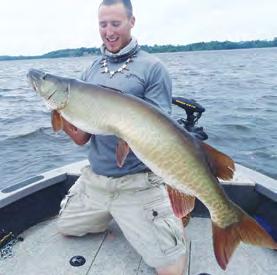

Northland has been a good sponsor for many years and staff from the Minnesota tackle company have come for several trips up to Lake of the Woods and Sunset Country over the years to
Anderson concedes, “because they do it wonderfully. It is just that day in and day out I’ve recorded more strikes on baits that I can retrieve in a straight line, rather than lures that zigzag wildly off to the sides. Muskies don’t miss surface baits accidentally.


It’s a law of averages, as each hole becomes an opportunity to engage fish that likely didn’t see the previous jigging efforts. Being thorough also provides an understanding of a bar’s shape and how walleye relate to different components. This is powerful information to obtain. Over time you’ll learn the sections of the bar that are the most soughtafter by walleye and positioning yourself on these spots during peak times will catch more fish. Save these nuggets as waypoints.
Best Baits for Bars

They miss them on purpose. So I am all about the straight and narrow.”
There are many good lure options for plucking walleye from a bar. My A-List includes a range of jigging minnows, darters, and spoons. A few top picks include the Rapala Jigging Shad Rap, Rapala Rippin Rap, Lindy Darter, Northland Buck-Shot Rattle Spoon, Lindy Flyer Spoon, Sebile Vibrato, Williams Ice Jig, and Luhr Jensen Cast Champ.


Perch often turn up on the same spots we catch walleyes.

Indeed, Anderson, who has a degree in fisheries science, is about way more than “the straight and narrow”. Having carefully studied the different sounds and vibrations that top water lures make when you hop, pop, buzz and scurry them across the surface, he is certain, as I am, too, that it is the next frontier in muskie fishing.
“A fish can pattern sound much more easily than it can sight,” says Anderson. “And they can do it in both positive and negative ways.”
I carry a range of colours. Perch patterns are a must for walleye. Walleye relating to mid-lake bars may also feed on smelt and other silvery pelagic baitfish, so white and nickel-plated baits are key. Gold, chartreuse, and glow colours are also highly recommended.
test new baits before they are released. We’ll fish with the new baits and see how they do. This is often hard for me because I know the Buck-Shot Spoon will always work and I just live to catch every fish that I can. I’m of the attitude, if it works why change it, but new baits bring different actions, sounds and colour options that can be even more effective depending on the day, the waterbody and the fish species.
Referring to a recent sturgeon study on the nearby St. Lawrence River, in which scientists anethescised and then surgically placed radio tags inside the fish so they could follow them, Anderson recalls the lead researcher telling him they had to turn off the water pump inside the tracking boat before the fish would let it get near. It appears the sturgeon recognized and associated the distinct frequency of the water pump’s ping with the previous negative experience.
(Continued on page 49.)
The new Buck-Shot Coffin spoond are fish catchers. I like to try bright & natural colours and let the fish tell me what the want.
Key attributes of a jigging hard-bait is versatility. It must have flamboyant moves that attract fish as well as muted manoeuvres for persuading fussy walleye to hit. The above

(Continued on page 27.)
(Continued on page 14.)
Just Fishing . 48 Winter 2023
Just Fishing . 26 Spring 2017 Just Fishing . 12 Winter2017
(On Top of the Muskie World continued from page 24.)
There are many good spoons out there, made by several companies, that are effective for walleyes under the ice. For me, I have fished all of the different models that Northland has released over the years and the ones that stand out the most for me are the Buck-Shot Coffin Spoon that has been around for the past couple of seasons and the new Glass Buck-Shot Spoon, which is making its debut this season. Both have done very well on the end of my line.





These two spoons offer a different profile from the original Buck-Shot and the new glass model offers a slightly different sound. Having used rattling and non-rattling spoons over the years I have no doubt that rattling spoons produce more bites than silent spoons. They aid in calling in fish from a little wider area and just seem to trigger bites. If you are fishing water that is extremely pressured and the fish are hard to catch, silent spoons might be better.
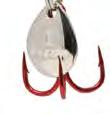
When it comes to rigging up for spoon fishing for walleyes, I like to use an ice rod in the 35”-39” range, in a medium action. If I’m fishing water with big fish, I like the longer models that offer a little more shock absorption. I have been using the G. Loomis IMX PRO ice rods the past couple of seasons and they are a pleasure to fish with. They are high end ice rods that allow me to feel a walleye breathe on my spoon.


I like a 1000 size spinning reel, some 8-lb. Power Pro ICE braid and an 8-lb. fluorocarbon leader. If the spoon doesn’t come with a split ring, I like to add one or use a small snap to give the spoon more swing when I’m jigging it. Finally, I always tip the spoon with a




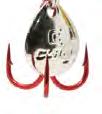


minnow head, usually from a frozen shiner. Adding meat will get more bites than using the spoon without and a head is better than a whole minnow. A whole minnow will hinder the action of the spoon and makes the profile to big.


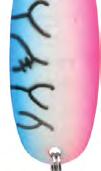

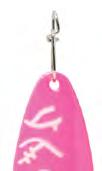
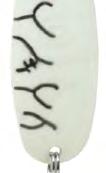
Have a great season on the ice. If you aren’t using electronics out there yet, you can make your adventure more fun and more productive by adding some sonar and using mapping to find the best places to fish. Spoons are effective ice baits for all species under the ice but especially for walleyes, where I don’t think there is a better option.
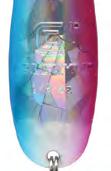

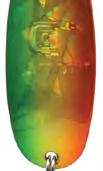

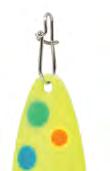

Watch how fish react to your spoon and then switch up with jigging cadence or maybe the size and colour until you figure out how to get every one of them that comes in for a look to bite.





Editor’s Note: Jeff Gustafson grew up on the shores of Lake of the Woods in Kenora, Ontario. He has made his living in the fishing community since he was a teenager as a tournament angler, guide, outdoor writer and fishing promotor. In 2019 he is competing on the Bassmaster Elite Series in addition to competing in several events in Ontario. You can find him on social media at @gussyoutdoors and on his website at: www.gussyoutdoors.com.

Just Fishing . 49 Winter 2023
(Using Spoons & Electronics on Ice continued from page 48.)
1HOW JOHN HOYER TRACKS DOWN TROPHY BLUEGILLS (EARLY-ICE)

 BY: BRETT MCCOMAS
BY: BRETT MCCOMAS
FFirst ice might be your best opportunity of the year to catch truly huuuuge bluegills. Here’s how (and where!) big-fish junkie John Hoyer targets ’em when things lock up, and it’s likely not where you’d think.


LOCATION
Most folks zip straight off to the weeds... while Hoyer runs with the bulls in 15-300 F, focusing on soft-bottom basins that flatten out at the base of a saddle or shelf
Hoyer: “They’re out on deep flats that have bug life going on –especially the trophy-sized fish. They’re following the food and not really holding to structure.” When drilling holes, he starts in deep water at the base of a drop-off and moves OUT from there:
TIMING
Bluegills are picky when a lake first caps. Hoyer says, “they’re crabby” and “it takes a week-ish for them to adjust to it.” When fish start actively feeding again, time of day is crucial: “Big bluegills will shut off completely for long stretches – you have to hit the feeding windows, which are usually at first light and then dusk into nightfall.”
You can NOT rule out a lake for big ‘gills until you’ve spent time trying to locate fish at lowlight dusk. He’s also a big believer in overcast days with a falling barometer = fish are more likely to feed all day
“That’s when we’ll make a long run to a known trophy lake. Other than that, it’s basically the 2 feeding windows.”

TACKLE
Any light rod combo will work – the key is a bite indicator, like a spring bobber or noodle rod. “You have to be able to see the bite, because 90% of the time, you won’t feel it with gloves on.”

Hoyer fishes 3-lb Berkley Trilene Micro Ice Mono, switching to fluoro (which sinks) in deeper water to boost the bait’s drop rate. And here’s why he says 3-lb is the deal. “4-lb is too thick, and 2-lb will lead to heartbreak on a hookset, guaranteed.”

Lure selection isn’t as meticulous as it can get later in the season. “I usually go with a 1/16-oz tungsten jig or a 1/16-oz spoon. I’ll tip it with a red Berkley PowerBait Whipworm or Mayfly, and I’ll always have a bait puck of Euro larvae on hand, too. The key is getting it down in front of their face fast when the bite is on.”

Leans towards dark colours for bluegill, including red, black and motor oil.
He’s also partial to lures outfitted with a razor-sharp Berkley Fusion19 hook.

TACTICS
Hungry bluegills often suspend low in the water column. “You’ll see them 2-5’ off the bottom. Sometimes, you can watch them compete for your lure on the flasher – that’s when you can really wail on them.”
Once he marks a fish, he moves his bait 12-18” upward while quickening his jig cadence to mimic fleeing prey. “Then you let them catch up to it and eat it.”
Using a flasher also helps visualize the way bluegills feed using lateral line vibration. “A 1/16-oz lure will be a thick red mark, like a fish. If I’m getting denied, the first thing I’ll do is downsize jigs. The smaller jig shows up as a thinner, green line, and that lighter frequency is the same thing that happens on a bluegill’s face. When the bite is tough, less is more.”
And if you’re lucky, you might just hit a dusk plankton bloom on some lakes, and then: “It’s go-time. It gets so thick you can’t even mark your jig, but that’s their food source. If you hit one of those hatches, the bite is usually good as late as you want to stay.”

Just Fishing . 50 Winter 2023
REPORT
(Continued on page 51.)
HUNTING EARLY-ICE WALLEYES WITH BRAD HAWTHORNE
 BY: BRETT MCCOMAS
BY: BRETT MCCOMAS
arly ice is one of the best times of year to chase walleyes – and no doubt jigging ’em up through the hard deck is always a treat! Here’s how walleye-hunter Brad Hawthorne finds fast walleye action after the first freeze and go-to baits/setups he won’t hit the ice without.

FINDING FISH
When lakes lock up, Brad starts looking for walleyes on structure near the first break, targeting 18-34′ (the deeper, the better). But as soon as safe ice builds further out, he’s off to the mud flats...
Hawthorne: “The mega schools are out in the mud. That’s where we head as soon as it’s safe. Before then, we’ll fish first break rockpiles.”


Believe it or not, he says structure often takes a backseat – new technology has changed what he’s looking for. Using his Humminbird Mega 360 Ice Adapter kit, he wants to see walleyes under the ice before he sets up shop. “If you fish where the fish are, you’ll catch them. I always use my electronics to mark fish before I start fishing. I’ll drill a hole in the middle of nowhere and throw
the Humminbird 360 down. If there are fish around, we start fishing. Otherwise, we keep hunting.
“360 has changed what I thought about walleyes... They’re not just sitting on the bottom. Walleyes never stop moving. You can see the walleyes establishing a trail – the line they’re working... how they’re moving through the area and how they’re using the structure. After so many repetitive times of seeing a walleye come through within 10′ of an area... tells you where to set up. Literally only have to drill one hole with this system to establish that... watch the screen, then drill your holes accordingly. Not spending any time turning the unit around looking for fish... it’s automatic... constantly scanning.”

Man, that’s wild. Almost like he’s picking a location for a deer stand on hightraffic trails...
Case you missed it, Brad posted a reeeeally in-depth video on exactly how he sets up his Humminbird MEGA 360 for ice.

Visit – www.targetwalleye.com –Consider signing up to receive FREE Target Walleye/Ice emails (Target Walleye continued from page 50.) Just Fishing . 51 Winter 2023
2 E E
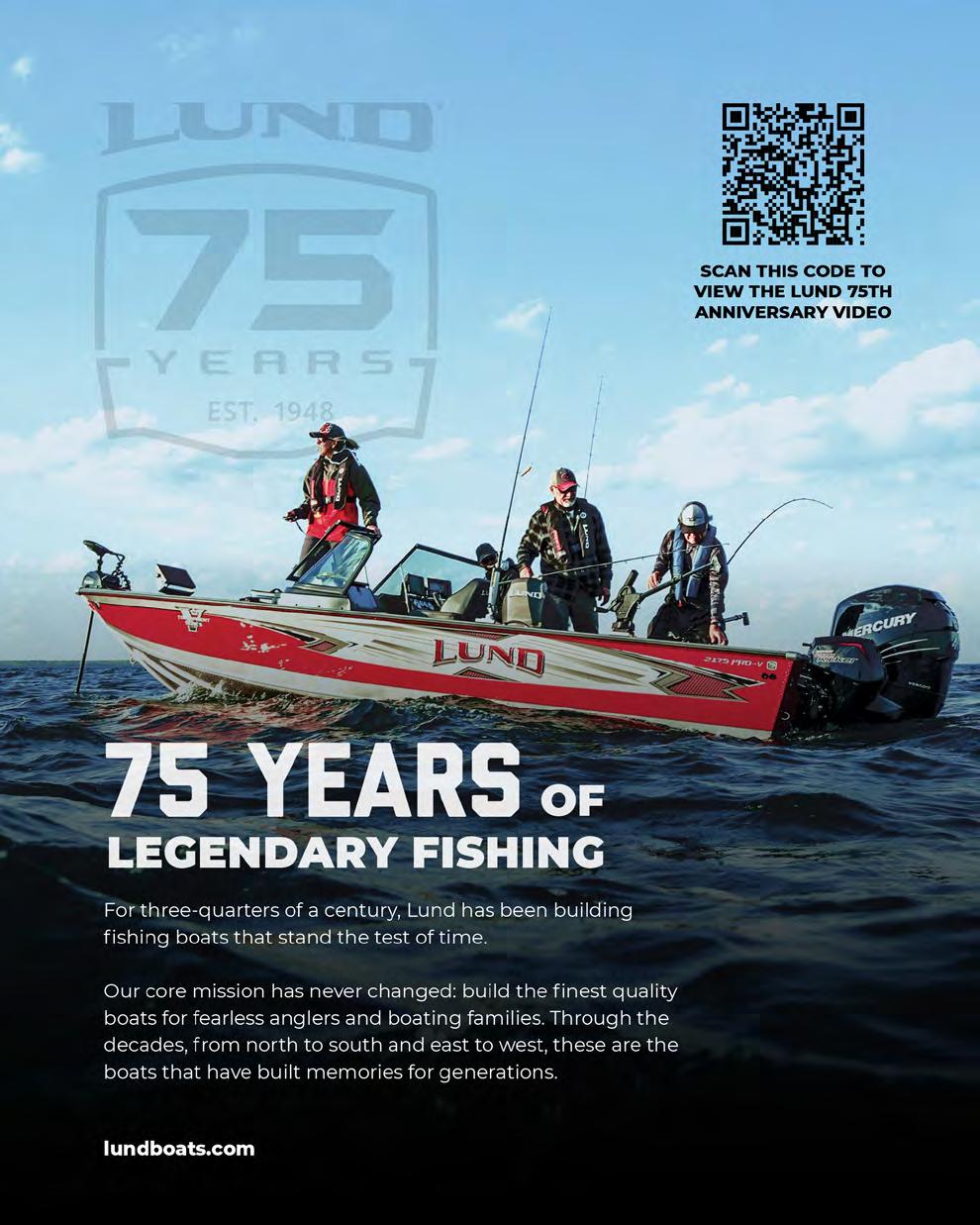
AAnglers in most parts of the Ice Belt have something a little different in mind when they talk about “First Ice”. It might be shallow parts of a flowage, small shallow lakes in Minnesota, Ontario or shallow lakes and overflow ditches in Manitoba. Most first ice spots are at the north end of water ways because of the angle of the sun. Veteran anglers know their surroundings and have their own list of areas to check. This doesn’t mean the north end of the lake necessarily, it is the north end of everything, including the south bays or connected waters. It is the north end of the water, it’s the angle of the sun giving the north end of everything a head start with the cold. We are talking percentages and it is not 100%.
The first check on the ice conditions is usually a little road trip with the truck, looking through a list of places anglers already have in their minds from past seasons on what and where to check. Topo Maps are a good place to start for those who don’t have any good ideas of their own on where to start. Veterans even like to look at maps, it can give them new ideas or refresh their minds on what their area looks like.
Looking and planning on where to go is fun and can result in having a spot you can return to for years, unless you spill the beans or get picked off by someone using other people as search tools and not doing their own homework.
Anglers in my part of the country have one of the best options anywhere for walleyes early in the season. Upper Red Lake and Lake of the Woods is as close to a walleye mecca as exists anywhere in the Ice Belt. There are miles of shoreline that freeze fast and are loaded with literally tons of aggressive day bite walleyes living in shallow stained water.
The stained water means you can use 8 pound test Sunline and more aggressive jigging patterns. You can also use minnows and bright coloured lures, although I like shiners and Northland lures like the Glass Buckshot Spoon with a high pitched glass rattle & also a good selection of Bro Bug Spoons, and
WHERES & WHENS
By: Brian “Bro” Brosdahl
ultra-aggressive Coffin Spoon. Gamakatsu #4 & #6 Red Octopus Hook w/ a live minnow.
I use St. Croix Custom Ice Rods, they are arguable the lightest most sensitive rods and made from scratch , rod blanks to a work of art. You can feel the difference in a 32” MF search bait or a 38” MXF Eye Raiser or the ever productive 32” MN Dead Eye.
of taking the hardest option in the past, but now I embrace the “easy button” like it is my favourite pillow.
I take my Humminbird Helix 9 G4 MEGA LIVE Ice bundle with the latest in build your own ice maping. I bring my AquaVu 822 its built like a tablet with a camera cord reel on the back, super bright with HD quality and in recording. For finding green weeds and fish. I will use a RAZR electric drill to test the ice and RAZR my holes. I use my Fish Monkey Yeti gloves to prevent the pull rope from pinching my hands and to keep my hands warm and dry in any conditions.
Did I miss anything else? Oh yeah, you can fish all day on stained water, then have a good flurry of action at low light and still have a good chance for a night bite if you want to stay late when the ice gets thick enough for houses. In the north country there are many more options for early season walleye spots and other species that are connected to the shoreline and can be accessed without crossing over any basin areas.
The fall bite doesn’t end in the fall it continues to early to mid-winter. This is the best time to fish for Walleye, this will last past the new year until the parking brake gets bumped in February. This is where they rest to fatten up for the spawning run only a few short months away. I don’t like fishing for walleye during their resting period, lol!!
Some of these areas include Lake of the Woods, shallow bays that would harbor water fowl creek channels that are connected to other areas please note, current is not ice friendly, remember to chisel and RAZR ICe Auger your way. I will outfit my Otter Resort house to pull out by hand, but you can bet I watch the ice conditions and will switch to my Can-AM SXS or SkidooExpedition snowmo’ or my “little car” as soon as the ice conditions allow it. I used to get accused
I bring rods rigged with my main search baits and a few RAZR puck bait containers full of maggots and wax worms for bait. I will have rods set up with smaller jigs in case it is a finesse bite and heavier rods for jigging. I also fill a RAZR puck with some pre-cut minnowheads in case the wax worms and maggots are not the answer for live bait. I also need a small cooler for some snacks and drinks and a bucket to bring some fish back home to have for a fish dinner at night.
I use the Ice cleats for my boots and will always have a set of emergency ice picks around my neck to pull myself out of the ice in an emergency. The buddy system with a throw rope and a floatable cushion is also important, but you need a good buddy or a spouse you can trust with your spots. Finally shallow lakes have plenty of spots for early ice, with even some series of ditches and sloughs are holding nice fish. Now it’s time to hit the ice!
Good Luck & Be Safe
Ice Fishing Anglers



– follow the daily adventures on my social media platforms, Bro.
Editor’s Note:

Brian “Bro” Brosdahl, of MAX, MN, is one of the most recognized and respected anglers in North America. Bro, as he’s known, is a multi-species angler best known for his influence on the sport of ice fishing. He can be contacted at bbro@paulbunyan.net or online at Brosguideservice.com for winter and summer guide trips or to book Bro for a seminar.
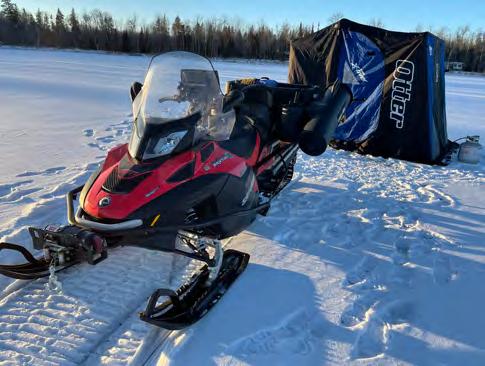



Just Fishing . 53 Winter 2023











































 By: Gord Pyzer
By: Gord Pyzer
























































































































































































































































 BY: BRETT MCCOMAS
BY: BRETT MCCOMAS






 BY: BRETT MCCOMAS
BY: BRETT MCCOMAS























